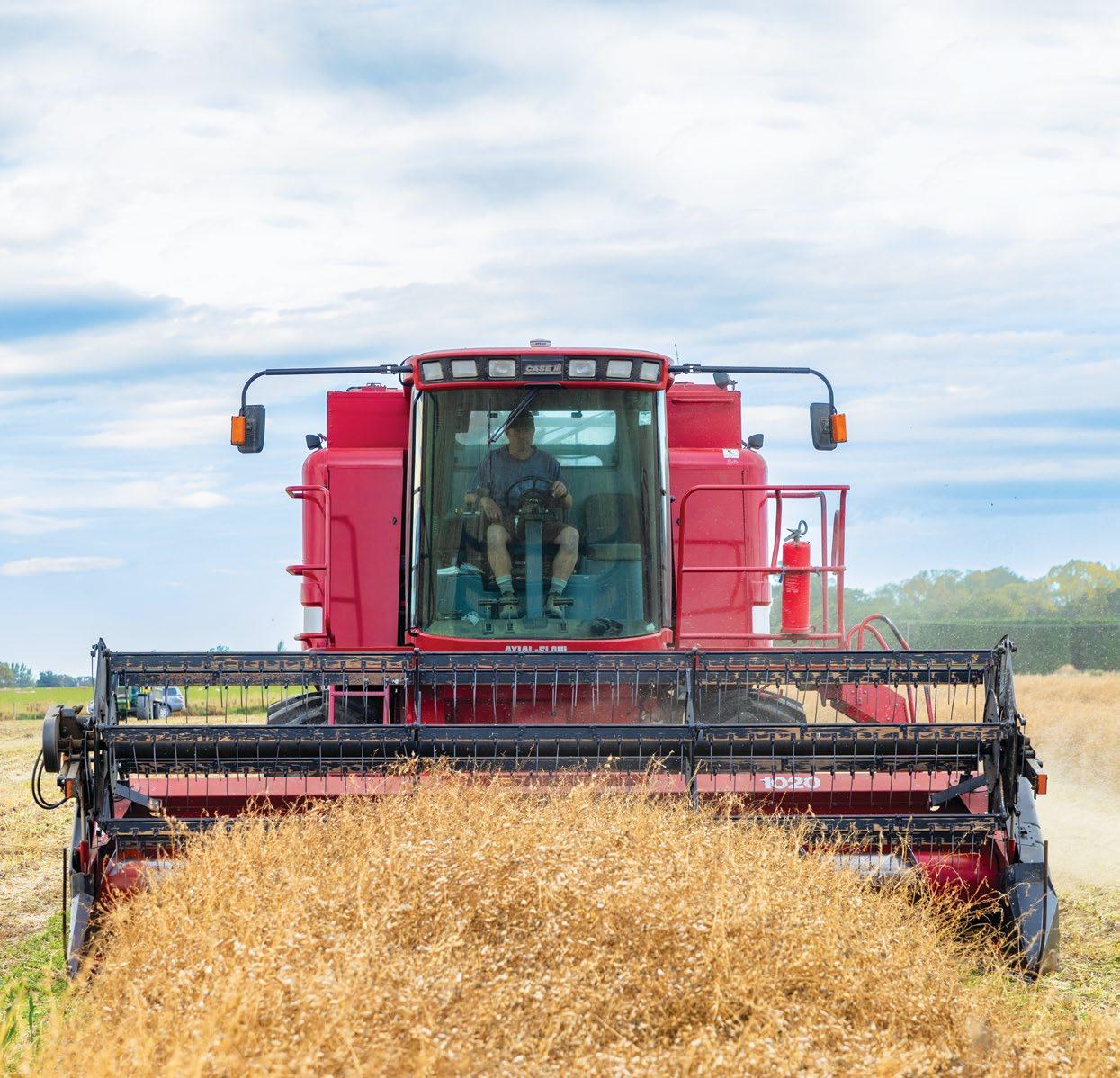

VOL 79 | NO 04 | MAY 2024 HORTICULTURE NEW ZEALAND 26 BLUE PACIFIC TRADE 42 LOCAL SUPPLY IN SUPERMARKETS 47 IPM RESULTS ON DEMO FARM SOWING SEEDS OF SUCCESS PAGE 37 FOOD SECURITY AND SUPPLY SPECIAL

Collaborating, innovating and supporting growers in New Zealand
Fruitfed Supplies works closely with growers, suppliers and industry bodies to support the success and sustainability of the fruit and vegetable sector.

Stay in the loop with the latest crop management practices, including product updates and tech tips.




SIGN UP NOW | Scan the QR code to receive our monthly email updates

We know horticulture
A trading division of PGG Wrightson Ltd

UP FRONT
2 President’s Word: Food security an issue for New Zealand – surely not!
4 The Chief Executive: Providing a reliable and resilient supply of fresh fruit and vegetables
YOUR LEVY AT WORK
6 No retreat from elite soils on flood plains
8 Vote in the HortNZ Levy referendum
10 HortNZ launches foundation health and safety training programme
15 Secondary markets and reducing food waste
18 Kūmara boomerang after sweet potato switcheroo
20 No growth without infrastructure
22 NZGAP marks 25 years of delivering trust
25 Consumer prices mask underlying economic and wellbeing concerns
26 Trading with our Blue Pacific neighbours
32 No silver bullet with GMO and gene editing
34 Roading a challenge but still best option for freighting food
37 Seed growers seek new pastures
40 Investing in our trade partners: Indonesia’s onion growers
42 The Little Guys – starting out as a commercial grower
44 Keeping the local in the national supply chain?
TECHNICAL
47 Harvesting crops with a lighter touch
50 El Niño in a changing climate
52 Integrating soil N testing with the SVS Tool
PRODUCT GROUPS
55 Potatoes NZ Inc.
57 TomatoesNZ Inc.
60 Vegetables NZ Inc.
61 Onions NZ Inc.



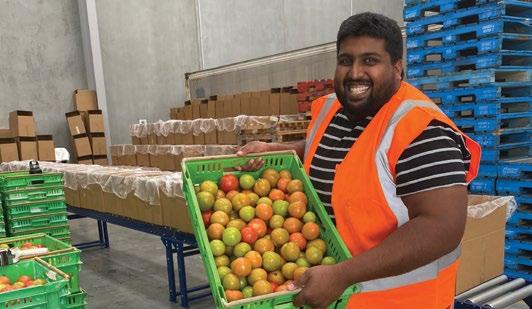
Seed grower David Birkett in Canterbury. See page 35.
CONTENTS 26 18 34 15 ON THE COVER:
Photo by Tony Benny.
YOUR INDUSTRY
NZ GROWER : MAY 2024 1
FOOD SECURITY AN ISSUE FOR NEW ZEALAND – SURELY NOT!
Barry O’Neil : HortNZ president
New Zealand exports over 80 percent of the food it produces, and our country can grow nearly anything with great soils, high sunshine levels, and a favourable temperate climate. Considering this then, why is Horticulture New Zealand raising the issue of food security for New Zealand?
Unfortunately because there are good reasons why we need to be concerned about Aotearoa New Zealand’s future food security.
While it’s a fact that over 80 percent of the food we produce is exported, this varies significantly depending on the type of food, and is definitely the case with dairy and meat and some fruit categories. However, over 80 percent of our fresh vegetable production is consumed within New Zealand.
Fresh fruit and vegetables are a really important part of our lives and positively impact our health. The New Zealand Ministry of Health and also the World Health Organization keep reminding us that one way to live healthier lives is to consume more fresh and nutritious fruit and vegetables. Likewise, 5+ A Day encourages all Kiwis to eat five or more servings of colourful, fresh vegetables and two servings of fruit every day for better health.
Scientists tell us that a diet rich in fresh vegetables and fruits can lower blood pressure, reduce the risk of heart disease and stroke, prevent some types of cancer, lower risks of eye and digestive problems, and have a positive effect upon blood sugar, which can also help keep appetite in check.
Although consuming all fruits and vegetables is beneficial health wise, when health studies have looked more closely into cardiovascular disease they found that green leafy vegetables such as lettuce, spinach, silverbeet, and mustard greens were most strongly associated with decreased risk of developing cardiovascular disease. Other vegetables such as broccoli, cauliflower, cabbage, brussels sprouts, bok choy and kale, along with citrus also made important contributions.
We know how to grow vegetables, so if there is demand surely we don’t have a food security problem… unfortunately wrong! About ten percent of Kiwi kids live in homes that are food insecure, but this increases to 25 percent for Māori, and 35 percent for Pasifika. It is believed this has been driven by the lack of affordability based on other family priorities, along with lack of education as to the value of eating a fresh healthy diet. There is also of course the issue of the time needed to cook rather than going for convenience with processed or fast food.

Unfortunately this has contributed to New Zealand having the third highest adult obesity rate of OECD (Organisation for Economic Cooperation & Development) member countries, with 30 percent of our adult population classified as obese, and even more unfortunately Māori are at 50 percent and Pasifika at 70 percent. The health impacts from this are huge, both for the individuals and for the ability of the New Zealand health system to provide care.
Over 80 percent of our fresh
vegetable production is consumed within New
Zealand
So how have we got it so wrong here, and what can be done to ensure plentiful supplies of affordable fresh fruit and vegetables for our population?
The real problem with vegetable production is while demand has (or should have!) increased as our population has increased, production hasn’t always followed. Overall, the number of vegetable growers has reduced significantly in the last ten or more years, primarily from family market garden businesses closing. A recent survey in Australia indicated 30 percent of vegetable growers are planning to exit the industry in the next 12 months if they can, due to lack of succession planning interest from
PRESIDENT’S WORD
2 NZ GROWER : MAY 2024
their family, along with low profitability – and my feeling is New Zealand is not far behind this scenario.
As a country we have been reluctant to put policy settings in place to protect highly productive land as urban sprawl continues. And much of this land is land that has grown vegetables. It’s nothing new. Lower Hutt vegetable production had to relocate to Horowhenua after the then government bought up large areas of prime horticultural land in the Hutt Valley during the 1920s for housing, leading to growers moving to Ōtaki and Levin.
Input costs have gone through the roof, with seed, fertiliser, diesel and labour being the main drivers, but prices for vegetables in general have not increased. There are always some unseasonal spikes, but in general vegetable prices have not kept pace with the costs of production; and with the use of distribution centres and the supermarket duopoly the grower often gets less than half of what the product is finally sold for, yet they take all the risks! And vegetable growing land is often very close to urban communities, which results in rates being high reflecting the value of the land for likely future industrial or urban development.
Water is essential for vegetable production but has become increasingly difficult to access as demand outgrows supply, and as I wrote last month while we as a country have an international competitive advantage with fresh water, we have failed to fully utilise this wonderful asset. Vegetables are often grown using rotation, so moving crops to different locations within a catchment is normal, but the regional policy settings often don’t provide for this, nor for moving water allocation in the process. It’s bonkers that dairy farming is a permitted activity or has a viable consenting path in our key growing vegetable regions, but that vegetable growers can’t get the consents they need to operate!
VEGETABLE PRODUCTION HAS A VERY SMALL FOOTPRINT OF AROUND 50,000 HECTARES, OR 0.5 PERCENT OF ALL FARMLAND
Environmental restrictions related to sediment run-off, nitrogen application, along with social licence issues from noise, dust and spraying have all put increased pressures on the ability to grow vegetables, or to grow them where growers want to, and in a way that production is sufficient to provide a viable economic return. Vegetable production has a very small footprint of around 50,000 hectares, or 0.5 percent of all farmland, yet it is one of the most restricted agricultural activities.
HortNZ has been strongly advocating for policy settings to address these areas, to allow for all horticulture to grow and expand, including for vegetable growers to do what they do best, grow fresh healthy and nutritious vegetables. Sometimes we get criticised that with food security we are being too domestically focused with vegetables, and there is a perception that we are not putting equal efforts into supporting export industry issues, which is not correct. But also the reality is that the related risks and restrictions involved are impacting on all horticulture, whether that be the future growing of vegetables or fruit.
We will continue to advocate strongly for logical and sensible solutions that are needed for future horticulture production. Our three priorities which I have covered over the last three months in this column, are climate mitigation and adaptation, water use and storage, and last but not least, food security. Our recent engagement with growers over our levy renewal has reinforced the importance of all three, as covered in our Growing Together 2035: Aotearoa Horticulture Action Plan
Kia kaha
Acting Editor: John Gauldie
Email: editor@hortnz.co.nz
Advertising Manager: Debbie Pascoe
Ph: 027 485 8562
Email: debbie.pascoe@hortnz.co.nz
Design: Scenario Communications
Ph: 04 385 9766
Email: joy@scenario.co.nz
Subscriptions:
Email: info@hortnz.co.nz
NZGrower is produced by Horticulture New Zealand and is free for all levy payers. The magazine is also supported by: Vegetables NZ, Process Vegetables NZ, TomatoesNZ, Potatoes NZ and Onions NZ
The individual comments and views in this magazine do not necessarily represent the view of Horticulture New Zealand.
ISSN: 2230-2700 (Print)
ISSN: 2744-5712 (Online)
This publication uses vegetable based inks and environmentally responsible paper produced from Forest Stewardship Council® (FSC®) certified, Mixed Source pulp from Responsible Sources.
Paper produced using Elemental Chlorine Free (ECF) and manufactured under the strict ISO14001 Environmental Management System.
The wrapper we use is 100% recyclable, it is LDPE 4 (Low Density Polyethylene) Soft Plastic and meets the required standards. For further information refer to: https://www.recycling.kiwi. nz/our-story
NZ GROWER : MAY 2024 3
THE CHIEF EXECUTIVE
PROVIDING A RELIABLE AND RESILIENT SUPPLY OF FRESH FRUIT AND VEGETABLES
Nadine Tunley : HortNZ chief executive
With autumn well and truly with us, I’ve been reflecting on the outcomes of our meetings with growers over the past few months.
I’m pleased the feedback from these meetings across the country has confirmed we are broadly on the right track.
Growers clearly have the same top priorities as Horticulture New Zealand – water, climate change and adaptation, and food security and supply.
Across the globe, the notion of food security has become increasingly important, and in New Zealand a key aspect of that is access to fresh fruit and vegetables. We also know that fresh fruit and vegetables are fundamental to human health and wellbeing.
The horticulture sector plays a vital role in New Zealand’s food security. Approximately 80,000 hectares of land is used for producing fruit and vegetables, providing over 40,000 jobs. Over 80 percent of fresh vegetables grown are for the domestic market, with many varieties of fruit also serving the New Zealand market.
For years, New Zealand has taken food security for granted. However, the Covid-19 pandemic and ongoing adverse weather events, such as Cyclone Gabrielle, have shown us that it is possible to suddenly have supermarket shelves empty of fresh produce.
Increasing growers’ ability to grow and expand by improving access to land and water will improve food security and help increase supply and therefore, the availability of fresh vegetables across New Zealand.
HortNZ is advocating for policy and regulatory settings that enable growers to provide a reliable and resilient supply of fresh fruit and vegetables and contribute positively to New Zealand’s food security.

That’s why we recently called on the government to ensure changes to the Resource Management Act (RMA) do not put vital domestic fruit and vegetable production at risk.
We are seeking a range of amendments to proposed reforms, including recognition of the national importance of protecting highly productive land (HPL) for primary production and enabling the supply of fresh fruit and vegetables.
Increasing growers’ ability to grow and expand by improving access to land and water will improve food security
We accept that people need houses to live in, but they also need to eat fresh fruit and vegetables. If the government makes building houses easier, then it also needs to make changes to the RMA to enable the supply of fresh fruit and vegetables.
If the amendments do not recognise the importance of domestic food supply, it will increase the risks to New Zealand’s food security and exacerbate the cost-ofliving crisis.
The New Zealand population grew by 138,000 last year, but council rules are currently preventing vegetable growers from growing more produce.
While housing has gobbled up highly productive land over the past ten years, the area for growing vegetables has not expanded at all. This is because the RMA is preventing vegetable growers from expanding in many regions.
It is vital for our country’s food security that fresh fruit and vegetables can be grown and supplied through a network of growing areas all around the country.
4 NZ GROWER : MAY 2024
Providing for the supply of fresh fruit and vegetables will help growers produce more healthy food to feed New Zealanders at a reasonable cost, while incorporating best practices to boost our precious soils.
New Zealand’s existing food production systems are coming under increased pressure from population growth, climate change, and the need to improve environmental outcomes.
The importance of food security should be explicitly recognised to ensure that a reliable supply of fresh and healthy food for New Zealanders is achieved.
NEW ZEALAND’S EXISTING FOOD PRODUCTION SYSTEMS ARE COMING UNDER INCREASED PRESSURE:
POPULATION GROWTH
CLIMATE CHANGE

2024 Horticulture New Zealand Director Elections
Calling for Nominations for two Directors
The Horticulture New Zealand constitution provides for a term of three years for elected directors.
The following Directors retire by rotation this year.
Bernadine Guilleux is retiring by rotation and is offering herself for re-election.
Brydon Nisbet is retiring by rotation and is offering himself for re-election.
There are two vacancies to fill.
In accordance with Clause 12 (e) of the Horticulture New Zealand Constitution nominations are now being sought from individual grower members, affiliated Product Groups and affiliated Grower Associations. Candidates must be nominated by at least two grower members or affiliated organisations.
The election is based on electing the best person for the job with no allocated seats for product, sector or regional representatives.
Candidate criteria
Nominated candidates must be:
• a person who is an active grower member of HortNZ; or
• a director, shareholder, partner or trustee of an active grower member who is appointed by that member as the principal representative of the entity in their dealings with HortNZ; or
• an employee of an active grower member who is appointed by that member as the principal representative of the entity in their dealings with HortNZ.
If more than two (2) candidates are nominated, an election will be held where individual grower members will vote for their preferred candidate. A profile for each candidate will be included with the voting papers distributed to growers.
The nomination form and position description is available on HortNZ’s website www.hortnz.co.nz or can be requested from the Board Secretary by emailing admin@hortnz.co.nz or by phone 0508 467 869.
Nominations close at 5.00pm on Friday 5 July 2024
ENVIRONMENTAL OUTCOMES NZ GROWER : MAY 2024 5
YOUR LEVY AT WORK
NO RETREAT FROM ELITE SOILS ON FLOOD PLAINS
Highly productive land, New Zealand’s elite soil, is a precious asset for our fruit and vegetable production.
It is no accident that this fertile land often sits on flood plains, because flooding or moving boundaries of water bodies allow nutrient-dense sediment to settle on the land. With the knowledge that climate change will bring more severe rainfall and flooding events, policymakers have considered how New Zealand should adapt our planning processes. It makes sense that building new housing, schools or hospitals in the paths of future floods and slips is untenable, but the flood plains that are restricted for development should still be utilised for food production.
Despite the oft-cited statistic that New Zealand produces enough food to feed 40 million people, that number only applies if people are happy to subsist on milk powder. Our country’s fruit and vegetable supply is under pressure from restrictive planning rules, the high cost of inputs and labour, and market pressures. The more that climate change and geopolitical events put the squeeze on international supply chains, the more likely that imported food becomes unaffordable or unavailable and the more important it is that our geographically isolated country can grow our own food supply. Although horticulture should not retreat from highly productive land, we still need to protect our food resources from floods, to build resilience into our food system and ensure our population has access to affordable, healthy and culturally appropriate food. Drainage works, channel clearance and ongoing maintenance of flood protection infrastructure are needed in the rural environment to avoid or mitigate the effects of flooding and support rural production.


The government needs to continuously strengthen grey infrastructure like stop banks and remove silt and shingle from flood channels to prevent dangerous debris flows.
Regional councils should be directed to work with the rural community to coordinate and align private and public drainage systems to ensure that flood waters do not leave public networks just to subsume production land. Flood protection should cover areas where high capital safeguards are in place to protect investments like orcharding trees, which take several years to pay for themselves. Flood protection infrastructure should not be designed such that it worsens flooding on horticultural land, because that would exacerbate adverse impacts on domestic food supply.
We still need to maintain road connectivity when an area is determined too risky for housing but still suitable for food production. Roads are critical to ensure timely distribution of perishable produce from the source to consumers. This is especially important in times of natural disaster to ensure food security, so that growing areas are not cut off when we most need a consistent supply of food. Rural communities need multiple paths to evacuate in times of disaster in case one is cut off by a natural hazard like a slip.
There is a genuine risk to New Zealand’s food production and food security if horticultural businesses are accidentally caught in urban risk assessments and forced to retreat from highly productive land. Non-habitable horticultural structures and buildings that support horticulture but do not house people have a vastly different risk profile than residential areas. The policy framework for determining risk must accurately recognise the differences between urban and rural activities.
INDUSTRY
ISSUES FOR INDUSTRY GOOD
WIDE
6 NZ GROWER : MAY 2024
Emily Levenson : HortNZ environmental policy advisor
Read more on the Horticulture New Zealand website in our November 2023 submissions on:


Inquiry into climate adaptation and community-led retreat
WAIPĀOA RIVER
Tairāwhiti’s Waipāoa River created the Poverty Bay flats, an area that is both a flood plain and highly productive land (Land Use Classification (LUC) levels 1, 2 and 3). The land generates a large proportion of New Zealand’s vegetables, half its sweet corn and two-thirds of its citrus.

Proposed National Policy Statement for Natural Hazard Decision-making
HORTICULTURE’S PRECIOUS FERTILE LAND
Agricultural land use comprises approximately a third of New Zealand’s total land area. However, horticulture crops grow on a tiny fraction –about 0.3 percent. Compared to other land uses, horticulture returns a much higher value per hectare, thanks in part to the fertile soils of highly productive land.
AGRICULTURAL LAND USE IN NEW ZEALAND
SUBMISSION ON Inquiry into climate adaptation 01 November 2023 Environment Committee Name Submitter: Horticulture Zealand Supported by Asparagus Council, NZ Kiwifruit Growers Inc., TomatoesNZ, Potatoes Process Vegetables NZ, Vegetables NZ Inc Contact for Service: Emily Levenson Environmental Advisor Horticulture Zealand PO - WELLINGTON Emily.levenson Proposed National Policy Statement for Natural Hazard Decision-making 2023 CONSULTATION DRAFT GOVERNMENT
beef cattle dairy cattle grain other livestock fruit sheep farming vineyards vegetables NZ GROWER : MAY 2024 7

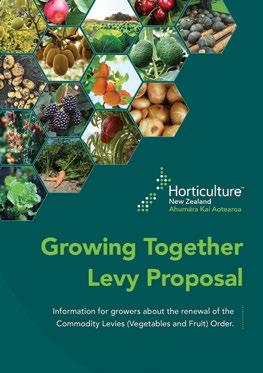

Vote to grow together
HORTNZ LAUNCHES FOUNDATION HEALTH AND SAFETY TRAINING PROGRAMME

Horticulture New Zealand in partnership with ACC (the Accident Compensation Corporation) is launching a major new initiative as part of its Grow Home Safe programme, with the aim of improving health and safety outcomes, particularly for seasonal workers.
The Foundation Passport – Horticulture course is an online training programme comprising five interactive training modules and includes hard-hitting personal accounts from workers who have suffered accidents.
Those completing it receive a digital site safety card to demonstrate they have undertaken basic health and safety training.
HortNZ Grow Home Safe project manager Matt Thorn said the project has involved input from 13 different grower groups and is based on a successful programme undertaken by the construction sector.
“We worked closely with every part of the industry from cherry orchards to kiwifruit growers and those producing vegetables – because we wanted to cover off all aspects.
“We looked at sectors such as the construction industry for guidance on how to roll out such a programme. The construction sector’s online programme enables someone joining a company from overseas to complete a course, and if they move to another company, they have something to show they have done that training.”
Grow Home Safe is run by HortNZ and is co-funded by ACC through a Workplace Injury Prevention Grant and HortNZ grower levies. Its goal is to enhance safety and wellbeing in horticulture, built around four objectives: Understand, Intervene, Support and Lead.
Each objective addresses a specific problem to establish new approaches to reduce harm.
Over 40,000 people work in the sector each year, many of whom are seasonal workers.
“Through working with employers, we identified the need to provide these workers with some fundamental knowledge about what to expect,” says Matt.
“It’s also about empowering growers to engage their workers in gaining health and safety knowledge and awareness.
YOUR LEVY AT WORK
10 NZ GROWER : MAY 2024
Creating content for the health and safety training programme at Lewis Farms
THE FOUNDATION PASSPORT – HORTICULTURE COURSE IS AN ONLINE TRAINING PROGRAMME COMPRISING FIVE INTERACTIVE TRAINING MODULES


“Some of it is very basic. Many of these people have
There is also a strong focus on addressing the key injury risks in the sector, including working at heights, and strains and sprains.
“A lot of work in the industry is paid by the bin, so the faster you work the more money you make,” says Matt. “We have covered sensible lifting practices, managing fatigue and the importance of taking breaks, eating properly and taking a day off if you need to because you won’t be able to work if you get injured.
“We have also split the programme into different parts, indoor and outdoor, because the risks in the packhouse, like forklifts, are going to be different to those working outdoors.”
Matt says the online programme should take about four hours to complete, and participants will need to be focused throughout.
“It’s very interactive, you can’t just press a button, go away and come back later and you have passed. You have to move icons around and put them in the right boxes and it’s designed so you have to watch the videos.


NZ GROWER : MAY 2024 11


Health advocates keep fruit & vegetables in the spotlight
Despite living in a horticultural paradise, many Kiwis still struggle to eat enough fruit and vegetables to achieve a healthy, balanced diet.
The Ministry of Health recommends people eat five or more servings of vegetables and two servings of fruit daily. But recent research conducted by 5+ A Day Charitable Trust shows only 23% of New Zealanders eat the recommended daily intake of vegetables with 71% of us eating enough fruit.
Those findings led 5+ A Day to partner with Vegetables New Zealand to launch a new campaign to encourage people to Add One More Vegetable to their daily routine.
“Adding
one more serving per day benefits overall health outcomes. Studies show consistent decreases in disease risk are observed when people increase the diversity of the vegetables they eat.”
Dr Carolyn Lister, 5+ A Day Trustee and Principal Scientist and Team Leader at Plant and Food Research.
For more information about 5+ A Day visit the consumer website: www.5aday.co.nz and the education website: www.5adayeducation.org.nz
Follow @5adaynz on socials
The charity’s efforts to raise consumption and improve public health outcomes often involves supporting our littlest tamariki to embrace fruit and vegetables.
Fruit and Vegetables in Schools (FIS) is now supplying approximately 25% of primary schools/ kura in Aotearoa, ensuring children from schools high on the Equity Index (most deprived) don’t miss out on eating fresh produce. Around 27 million servings of fresh fruit and vegetables are now eaten every year by over 125,000 students and staff from 566 schools.
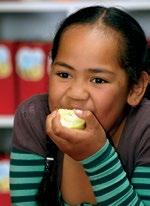


5+ A Day supports FIS by providing curriculumlinked resources that support learning on topics such as germination, composting and eating seasonally.
“Our free resources cover early childhood education right through to secondary school level. FIS supports food security for those who might otherwise go without. We’re making sure a whole generation of kids receive consistent, accurate health messaging.”
Carmel Ireland, Project Manager, The 5+ A Day Charitable Trust.





































Further 5+ A Day resources are also available for parents and whānau, health professionals and even workplaces who are keen to promote wellbeing. “The key is making fruit and vegetables an attractive, easy option and we’re constantly focussed on helping people incorporate more fresh produce into their daily diet.”
Legendary Olympian Dame Lisa Carrington has partnered with 5+ A Day for the past three years to help spread the word about the benefits of eating fresh fruit and vegetables for optimal physical and mental health.

Carrington is a popular partner for 5+ A Day and regularly appears in social media campaigns to draw attention to fresh seasonal produce and help boost domestic sales.
Other community sponsorships include the Life Education Trust and the Two Raw Sisters who together work to inspire and motivate whānau about the benefits of eating the recommended daily servings of fruit and vegetables.
“We also support the game-changing garden initiative, Oke Charity, which builds sustainable gardens for primary schools throughout Counties Manukau,” Ireland explains.
“About 1000kg of fresh produce is now being grown which provides a wonderful chance for tamariki to learn first-hand what it’s like to grow and harvest food.”
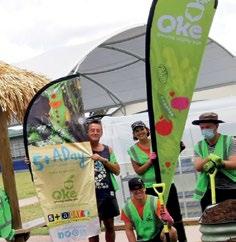

Ireland says 5+ A Day will keep looking for new and innovative ways to engage with New Zealanders to promote the vital role that horticulture plays in public health and wellbeing.
Tokamerengi Rōpere Kōhia Manarini Tōmato Pītiti Āporo Aperekoti Rahopūru Rēmana Raima Tiere Whītoa Āporo makimaki www.5adayeducation.org.nz Rīwai Amiami Kūmara Harore Atihoka Huatao Kareparāoa Pūpihi www.5adayeducation.org.nz Carrot Kāroti www.5aday.co.nz Sow: Spring, Summer, Where: In moist soil that has been worked to a deep but fine tilth, in full sun How: Sow seeds in rows spaced 10cm apart. Keep soil moist during germination. Thin seedlings to 3cm spacings Germination: 10-12 days Harvest: 10-12 weeks @5adaynz vegetable inspiration, nutrition information and giveaways. Seeds kindly provided by 23108_5+_Small Seed Packet TEMPLATE_v3F 2.indd 22/11/23 9:54 AM Radish Uhikura www.5aday.co.nz Sow: Spring, Summer, Where: Sow directly where they will grow, 6mm deep in full sun. Space rows 10-15cm apart Keep seed bed evenly moist. Thin to 3-5cm apart at two-leaf stage Germination: 5-8 days Harvest: 4-5 weeks. harvested when young as they will become pithy when over-mature Follow @5adaynz for fruit & information and giveaways. 23108_5+_Small Seed Packet TEMPLATE_v3F 2.indd
YOUR INDUSTRY
ACROSS THE SECTOR – ACROSS THE COUNTRY

NEW ZEALAND FOOD NETWORK’S AUCKLAND DISTRIBUTION WAREHOUSE
YOUR INDUSTRY
SECONDARY MARKETS AND REDUCING FOOD WASTE
In today’s economic conditions, finding the balance between healthy affordable fruit and vegetables and providing growers a living is proving more challenging than ever. New Zealand’s food security is becoming a hot topic in homes across the country, but there is no silver bullet answer. HELENA O’NEILL takes a look at the role growers are playing through secondary markets and grower food aid.
Angus Simms and Katie Jackson are the founders of Wonky Box, a business created from a determination to not only focus on how to reduce food waste at its roots but also increase access to nutritious food.
Angus says Wonky Box has been embraced both by growers and customers alike and has played a pivotal role in bridging the gap between them.
“Growers appreciate how we recognise the effort and quality put into every crop, ensuring that produce outside traditional specifications still reaches consumers. Our partnerships allow growers to maximise the value of their resources within the farm gate, preventing wastage of perfectly good food.”
Consumers can appreciate the opportunity to access fresh, nutritious produce at a budget-friendly price point, Angus says.
“Secondary markets can be incredibly important for growers for several reasons: They provide an outlet for produce that may not meet strict export or retail standards but is still perfectly good for consumption. There could also be a bumper crop or a flush on, meaning there is simply too much of a product than any one grower could sell to a single market.”
Horticulture New Zealand environmental policy advisor Emily Levenson says food waste and food loss are inefficiencies in the food system when food is grown and processed but doesn’t get matched with someone to eat it or another valuable end-use.
“The horticulture industry is interested in reducing food waste, especially through selling products made from the discarded parts of the plant or produce that doesn’t meet strict supermarket or export specifications.
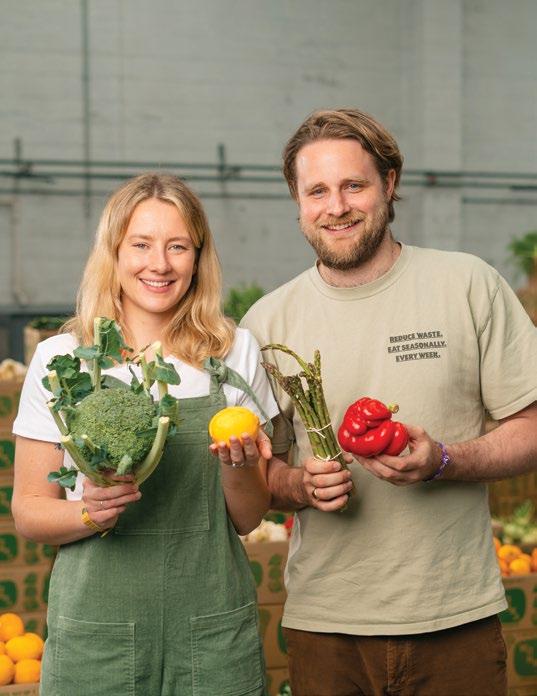
“For example, Eden Orchards in Central Otago produces cherry juice from the cherries that can’t be exported or sold domestically. Lots of produce may not have a market through traditional channels if it’s the wrong size, shape or colour.”
Emily says that secondary markets like ‘wonky’ produce boxes can make sure consumers still have the option to buy that produce, while growers are still compensated for all of the hard work, labour, time and inputs they expended to grow those fruits and vegetables.
“Currently, most ‘lost’ fruits or vegetables are donated or sold to farmers for animal feed, returning those nutrients to a different production system.”
The biggest challenge to repurposing fruits and vegetables that would otherwise be lost is increasing consumer demand for ‘odd’ produce and the research and development required to generate new value-added products, she says.
YOUR INDUSTRY
BUSINESS FEATURE NZ GROWER : MAY 2024 15
Katie Jackson and Angus Simms are the founders of Wonky Box


Washeem Shaheem, Warehouse Staff member at the New Zealand Food Network’s Auckland distribution centre, with a T&G Fresh donation of tomatoes
Gisborne orange growers Bron and Sandy Kemp run Twisted Citrus, which sells fruit boxes, picked to order, direct from the orchard.
Twisted Citrus has also embraced the secondary market, offering “imperfect seasonal boxes”, director Bron Kemp says.
“We don’t want any produce that we purchase from our growers to go to waste. While packing our premium fruit and gift boxes we always do come across fruit that is second grade – this fruit is used in our imperfect seasonal boxes.”
Twisted Citrus also dehydrates some fruit and sells it as a value-added product. The rest is donated to a local initiative Gizzy Kai Rescue and any produce that is past its best is given to a local farmer’s pigs, Bron says.
“I think every grower wants or needs to find fruit markets that do not comply with the premium grade market. There is nothing worse than seeing fruit go to waste on your orchard.”
Finding the balance of providing access to healthy, affordable fruit and vegetables while also providing growers a living is difficult to achieve.
“I know many local fruit growers who struggle to make any significant profit from their produce at present – even when the product is premium grade. This is due to recent weather events, and also the costs associated with growing produce and employing staff have gone up significantly, while the price returned to the grower has remained much the same –there just isn’t much money left over unfortunately.
“I do think having a market for second-grade produce helps reduce the cost for the end consumer, but the price returned to the grower still needs to cover their costs [in order] for it to work.”
Another way of reducing food waste is in the form of grower aid, donating produce to organisations like the New Zealand Food Network (NZFN) and KiwiHarvest.
T&G became a foundational partner of NZFN in 2020, says Adrienne Sharp, Head of Corporate Affairs, T&G Global.
“For many years, we’d directed our surplus fresh produce to food hubs and charities in our local communities but what we’d struggled with was having the ability to efficiently move bulk produce beyond the communities where our operations are,” she explains. “NZFN’s model solves this challenge and together with their private, social and government partners, they’re playing a pivotal role in helping get food to where it’s needed most.
Having a market for second-grade produce helps reduce the cost for the end consumer, but the price returned to the grower still needs to cover their costs
“Last year, T&G, together with our growers, donated 876 tonnes of produce to NZFN – which means we’ve donated about three million kilograms of fruit and veges since we first partnered with NZFN.”
The Supreme Sikh Society of New Zealand based in Takanini, South Auckland, is one of New Zealand Food Network’s 63 food hubs across the country.
Project manager Daljit Singh says that when the lockdown was imposed in February 2020, the society opened its doors to support the community to the best of its capacity.
“Initially serving primarily Indian recipients, we soon found ourselves aiding a much broader demographic, providing food to 3500 families daily.”
YOUR INDUSTRY
Katie Jackson from Wonky Box checks out the veges with Southern Fresh growers Garth Dunn and Carl Hodgson
BUSINESS FEATURE 16 NZ GROWER : MAY 2024
REDUCE FOOD WASTE BY ENCOURAGING KIWIS TO EAT
MORE FRESH FRUIT AND VEGETABLES
The society’s operations expanded to various locations including North Shore, New Lynn, Huntly, Ngāruawāhia, Tauranga, Rotorua, Hastings, Wellington, Queenstown, and Christchurch, with 95 percent of recipients from the wider community.
“With the support of Sikh growers from Te Puke, Hastings and Pukekohe, we were able to distribute 12 tonnes of food daily. Our efforts were recognised when we were nominated for the NZ Food Heroes award, which we proudly won.”
Daljit says the society joined NZFN in December 2020, covering from Huntly to Henderson in West Auckland.
“We are fortunate to have a network of 20 to 40 growers from Pukekohe, Tauranga, and Hastings who have been supporting us with food donations. Many of these growers have known me personally for two to three decades. When we announced our initiative to support the wider community with food parcels, their support increased significantly.”
While they were already assisting before the project’s expansion, grower contributions grew even more, Daljit says.
“Among these growers, there are four or five individuals who have become our backbone, consistently supplying us with the food we need to serve the community.”
On a national scale, KiwiHarvest chief executive Angela Calver says KiwiHarvest collects produce from 83 supermarkets daily, working with 44 growers or produce businesses in the last year.
“We are also focussed on ensuring that we are working with recipient agencies who value the food that we donate to them and that they are working on helping people break out of the situation they find themselves in by offering other wrap-around services, not just providing food.”
Angela says the top three reasons for KiwiHarvest receiving food are that it is nearing its best-before date, is damaged, or is oversupplied, in that order.
Another aspect of reducing food waste is ensuring that New Zealanders eat more healthy fresh fruits and vegetables.
Thirty years ago 5+ A Day was launched by United Fresh NZ Incorporated as an advertising campaign to encourage Kiwis to eat more fresh fruit and vegetables for good health.
Project manager of 5+ A Day, Carmel Ireland, says the campaign has come a long way since its inception in 1994. In 2007, 5+ A Day became a charitable trust and continues to work to encourage the consumption of fresh fruit and vegetables.
“We partner with organisations to deliver initiatives that focus on the education setting, including Oke Charity which offers vegetable gardening in schools, Life Education Trust and the Two Raw Sisters which run cooking workshops in schools, Stars Netball and the Stars 5+ Day Schools Club linking healthy eating with physical activity, and the Fruit in Schools programme which provides education resources that support fruit and vegetable consumption, including sustainability.”
United Fresh runs the government-funded Fruit in Schools programme, with members such as MG and T&G helping to distribute over 27 million servings of fresh fruit and vegetables to over 120,000 children and school staff at 566 schools in 21 regions.
Carmel says they also partner with product groups and organisations to target consumers with promotions and campaigns to drive consumption.
“Currently we are working with Vegetables NZ on the Add One More Vegetable promotion, Citrus NZ to promote all varieties of citrus throughout 2024 and the Persimmon Industry Council to promote the upcoming persimmon season.”

NZ GROWER : MAY 2024 17
KŪMARA BOOMERANG AFTER SWEET POTATO SWITCHEROO
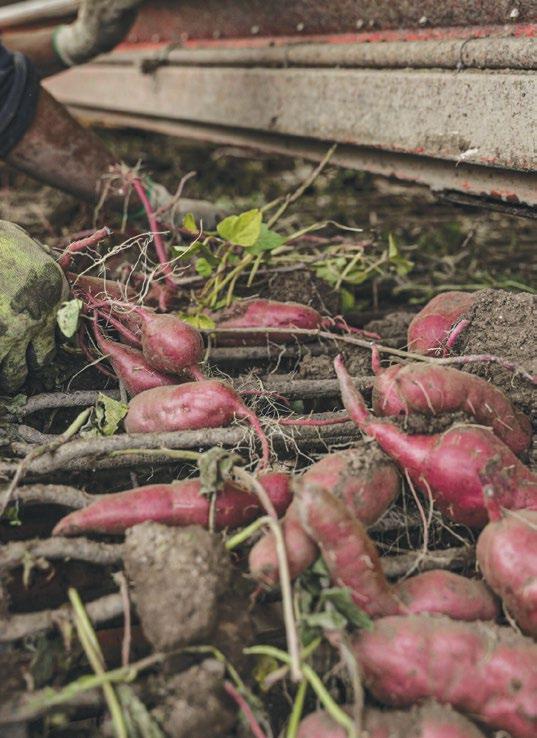

Kaipara Kūmara, which has supplied Nelson company Proper Crisps for a decade, was unable to supply the snack maker last year after severe weather devasted the kūmara crop in Northland.
Cyclone Gabrielle was the final blow in a weather trifecta which started with torrential rain and then saw the Auckland Anniversary Day floods. Ant Blundell, of Kaipara Kūmara describes it as a perfect storm.
“In our 50 years of harvesting kūmara, last year’s weather was by far the biggest challenge we’ve faced,” Ant says. But he is full of praise for Proper Crisps as a great customer and business partner.
“I’ll never forget the phone call I had with their team after the cyclone. After telling them almost all of our crop had been wiped out, they assured us they’d stick it out with us and sent us a pallet of chips to let us know they were thinking of us.”
Proper Crisps had to source Australian-grown sweet potato, and the product was packaged as Proper Crisps Sweet Potato to keep shelves warm while the kūmara crop recuperated.
But while the devastating impact of the cyclone resulted in an industry downturn of 70 percent, New Zealand’s local growers’ resilience has led to a good 2024 harvest. Now Proper Crisps is making good on its promise to bring back kūmara crisps.
YOUR INDUSTRY
NZGrower staff
Northland grower Doug Nilsson of Dunsmore Gardens and Ant Blundell of Kaipara Kūmara
18 NZ GROWER : MAY 2024
While the kūmara industry recovered, some chip lovers have had to eat Australian sweet potato instead

After a limited season of the Aussie variant, the company has resumed its long-term supply agreement with the local kūmara grower and placed an order for 700 tonnes of New Zealand-grown kūmara to make into Lightly Salted Hand Cooked Kūmara Crisps for this side of the ditch.
“The Aussies will get to keep their sweet potato,” Ant continues, “while our kūmara rightfully feeds Kiwi chippie lovers. I might be biased, but I’d say our version tastes a touch better,” he jokes.
What Australians might not realise is that Proper Crisps is selling kūmara crisps in Australia as well (made with New Zealand kūmara in the bag) but the product is called Proper Crisps Sweet Potato as that is what the Aussies recognise.



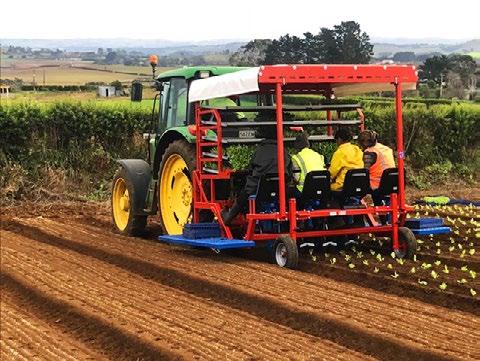 The kūmara harvest has bounced back and Kaipara Kūmara has resumed supply to Proper Crisps
The kūmara harvest has bounced back and Kaipara Kūmara has resumed supply to Proper Crisps
09 238 0770 021 959 948 nevoda@hyper.net.nz 70 Tuakau Road PUKEKOHE NZ GROWER : MAY 2024 19
NO GROWTH WITHOUT INFRASTRUCTURE
NZGrower staff

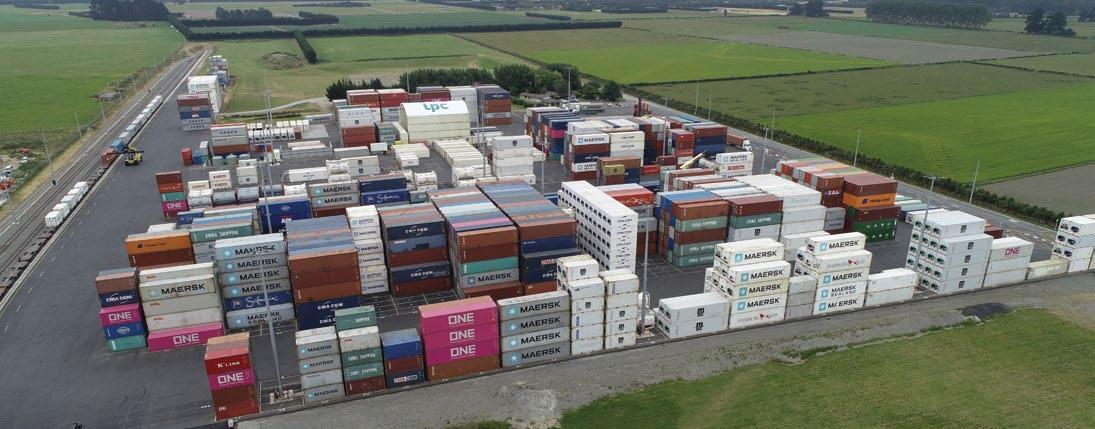
Mike Knowles, chair of the New Zealand Council of Cargo Owners (NZCCO), says the future of horticulture in New Zealand depends on a renewed focus on making our own domestic supply chain as efficient as possible with improved port productivity and making much needed investments in infrastructure to support this.
What is the state of New Zealand’s supply chain infrastructure?
“The global supply chain has suffered a number of shocks in recent years which have caused massive disruption around the world. Apart from the pandemic that really disrupted containerised shipping especially, you’ve got the two major shipping canals operating below capacity: Panama is coming right now but Suez is facing the geopolitical issues going on in that area. Now a container ship has taken out a key bridge in Baltimore, which will have a ripple effect as ships divert to other ports. These shocks are going to keep coming though, and they’re outside of our control. We need to control what we can control – focussing on having the most efficient domestic supply chain possible to make us competitive in our markets.
“We’ve become an expensive country to do anything in with costs rising everywhere. NZCCO believes there is room for improvement in the New Zealand port performance and productivity. Fees are going up, up, up but we’re not seeing any sort of return to the productivity that existed before Covid-19, bar at a couple of ports.
“Port of Auckland (POA) is a vital cog in the national supply chain, because it’s the main import destination and first port of call. So what happens at POA impacts the rest of the supply chain, if the ships get delayed in Auckland or cannot discharge/load all their cargo, this disruption flows on to the next ports of call for the ships. So POA working efficiently at a good productivity level is important for the whole country.”
Are shippers concerned by talk of privatising Port of Auckland ownership?
“There is a lot of chatter that costs will go up under a private port operator but costs are already going through the roof now under Auckland Council ownership. POA has already signalled the cost increases to come for the next five years, and other ports in New Zealand will be looking at what increases they are achieving. So we’re asking, how do we get them working more efficiently with infrastructure kept modern and current? I mean just in Auckland you’re probably talking about $700+ million required for new infrastructure and replacement over the next 35 years to keep it running. Is the council going to make that investment?
YOUR INDUSTRY
Inland hubs like MidlandPort in Rolleston, which has daily rail to Lyttelton, are of vital importance to prevent port congestion.
Photo courtesy of LPC
20 NZ GROWER : MAY 2024
“So we’re not averse to having a professional operator bringing their global expertise in running ports and terminals, with the appropriate KPIs around achieving certain productivity levels and reinvesting in the port infrastructure to keep it at the leading edge. A lot of people are jumping up and down about it, but you’re not selling the land, you’re selling the rights to operate the port and terminal. It’s a common model all around the world where the council or local government owns the port land and rents it out to professional operators. There will be lot of interest from the big international operators, and having that professional experience will have its advantages.”
Is lack of infrastructure investment holding back growth in horticulture?
“The consenting process for new infrastructure under the RMA (Resource Management Act) has been very challenging and has impacted the country negatively for many years now. I know the new government is trying to speed it up, but the RMA has been chronic with all the delays. The classic case in point is waiting six years for the Port of Tauranga simple berth extension and we’re not even there yet. We’re talking about critical infrastructure for the country’s biggest port to allow it to grow its capacity. Horticulture has a lot of growth coming in the next five to ten years, so we are concerned about how the port can function.”
Are roads king or will coastal shipping have a future role in inter island freight?
“Cargo will always flow the most efficient way. And road transport is more efficient at the moment – cheaper, quicker and more direct. Our roads are very important for moving domestic produce around. There’s some momentum now with the Roads of National Significance returning under the new government so some investment might actually happen.
“There is definitely a role for coastal shipping. We’re going into this era of decarbonisation including for shipping.
“The alternative fuels for ships are not as energy dense as heavy fuel oil so they require much bigger fuel tanks to allow the ship to steam the same distance, so ships will need to be that much bigger to be viable. We will see much bigger ships in the future than are coming to New Zealand now for that reason. And they won’t be going to every port in New Zealand.
“We see a future where it’s probably going to be a three-port strategy for these bigger ships. So Auckland for the imports and Tauranga for the imports and exports. And one other in the South Island, probably Lyttelton.
Coastal shipping will have a key role in moving freight to these three key hub ports, and the other ports will still exist but as feeder ports. It is important that they do continue to operate as feeder ports to provide resilience for the country in the event of a natural disaster.
However you connect them – road or rail – we need goods coming in and out moved quickly and efficiently
“When you are talking about the supply chain between the North and the South Island, the ferry services are a critical link, no doubt about it, including produce going both ways. We are concerned about the costs and definitely want to see at least two independent commercial operators on the Cook Strait to provide competition. Coastal shipping could also be a solution for this, but it does need to be cost competitive as well.
“Rail is a factor, too. The inland hubs are really important to keep the cargo moving so ports don’t become congested. Port of Auckland out to Wiri, Tauranga out to Ruakura, and Lyttelton to MidlandPort in Rolleston. However you connect them – road or rail – we need goods coming in and out moved quickly and efficiently. Safeguarding the freight corridors in and out of the ports to allow this to happen is of national importance.”

MULCH BRANCHES UP TO 90MM IN DIAMETER
NZ GROWER : MAY 2024 21
NZGAP MARKS 25 YEARS OF DELIVERING TRUST
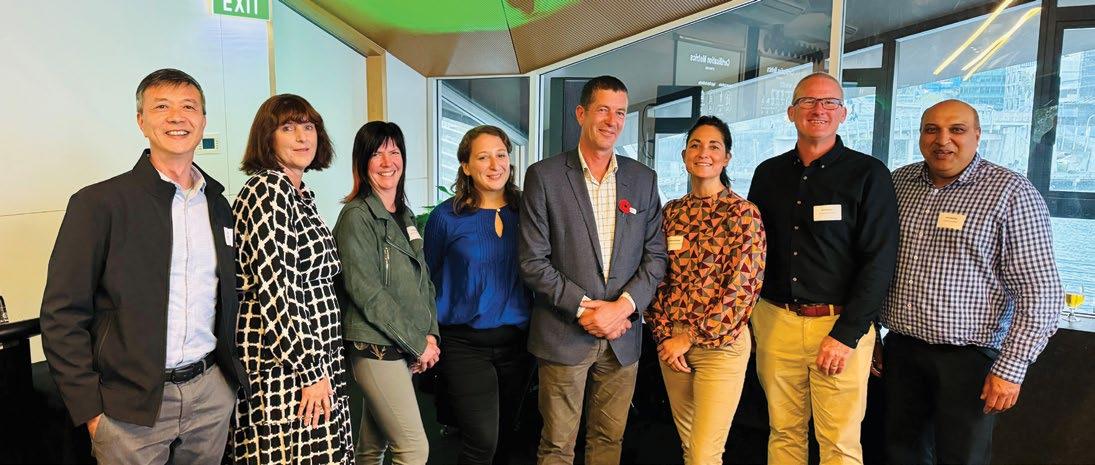
New Zealand Good Agricultural Practice (NZGAP) celebrates a major milestone this year after 25 years of providing assurance in the horticulture industry. Since the launch in 1999, NZGAP has been empowering growers to demonstrate the safe and sustainable production of fruit and vegetables, thus meeting the expectations of millions of consumers in New Zealand and around the world.
NZGAP general manager Damien Farrelly says that “consumers are increasingly concerned about the origin, safety and sustainability of their food. For 25 years now,
NZGAP certified operators have been able to demonstrate their commitment and ability to meet these expectations.
“It is fundamentally about protecting growers’ social licence to operate. NZGAP enables that both at an individual and sector level via the robust and trusted assurance system which has continually evolved over the years to ensure it remains trusted and valued.
A cocktail style event was held recently in Wellington to mark the 25-year celebration. In attendance were Mike Butterick (Wairarapa MP), founders, growers, retailers, wholesalers, auditors, regulators, product groups, district associations, Horticulture New Zealand plus current and former NZGAP committee members and managers.
YOUR INDUSTRY
22 NZ GROWER : MAY 2024
The NZGAP committee with Mike Butterick (Wairarapa MP) from left to right: Allen Lim, Kate Trufitt, Linda Flegg, Solenne De Durand, Mike Butterick, Bernadine Guilleux, Adam Jory, Kirit Makan
DELIVERING TRUST FOR 25 YEARS
During the evening event, Bernadine Guilleux (chair of the NZGAP committee), who was MC for the evening, recognised Russell Jordan and Ron Gall, the driving forces behind the development of NZGAP and founding members who supported the programme from the beginning.
“When researching the early years of NZGAP, you can’t go far without seeing the name of Russell Jordan. He himself will say there were numerous others that helped and I’m sure he was right, however he was the driving force.
“The journey of NZGAP has been marked by significant milestones, each one a testament to the dedication and collaborative nature of our industry. It could be said one of the first achievements of NZGAP was gaining agreement from both the Vegetable and Fruitgrowers’ Federations of the time to support just one Quality Assurance Programme. This set the foundation for things to come.
Minimising complexity makes sense to me, and I look forward to seeing more simplification and further red tape reduction
Mike Butterick stated, “Our industry is a collective of great farmers and growers, with quality products to share to the world. We need easy, effective verification systems to make sure global consumers know just how good we are at our job!
“NZGAP puts significant effort into simplifying how growers are able to meet both market and regulatory requirements. Part of our role as government is to solve problems not create them!
“Minimising complexity makes sense to me, and I look forward to seeing more simplification and further red tape reduction. This government has already made changes that support New Zealand food producers and I look forward to seeing even more over the months ahead.”

In relation to NZGAP’s recognition under the Food Act, Vincent Arbuckle, Deputy Director General for New Zealand food safety at the Ministry for Primary Industries stated “This initiative reduces costs and streamlines administrative processes for these businesses. It’s a win-win situation”.
“From a food safety point of view, the advent of NZGAP is significant because it takes a risk-based approach to food safety, requiring the identification and control of food safety hazards.
“This meant NZGAP registered growers were well positioned when the horticulture sector was included under the food safety regime for the first time with the introduction of the Food Act 2014”, Vincent says.
Glen Bewley, merchandise manager at Woolworths New Zealand, a sponsor for the event, is a strong advocate for NZGAP and recognises its importance to meet consumer expectations. “We all know that NZGAP significantly contributes to the food safety of the New Zealand horticulture industry. Our work alongside NZGAP helps us to be confident that we can source fruit and veg from businesses that pay and treat their staff fairly – and of course are of safe and good quality standards.
PLATINUM SPONSOR GOLD SPONSORS NZ GROWER : MAY 2024 23
NZGAP leaders, past and present, cut the cake. From left to right: Peter Ensor, Peter Silcock, Chris Sinnott, Matthew Dolan, Bernadine Guilleux, Damien Farrelly, Sandra Eden
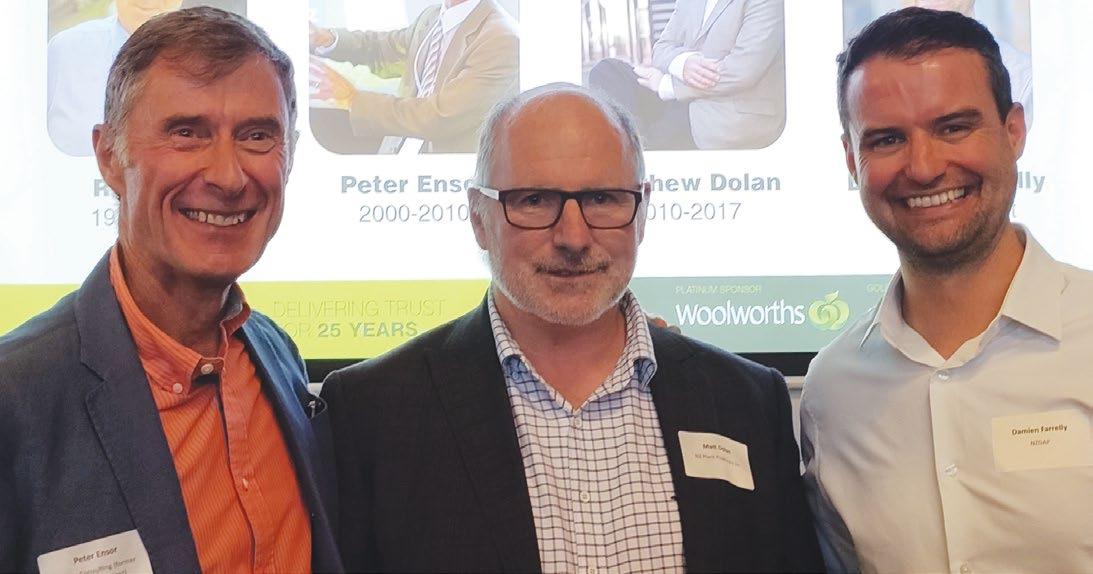
Damien Farrelly, NZGAP general manager, spoke about the value of NZGAP to the horticulture industry, and encouraged “even more collaboration and engagement in this space to help set NZGAP and our growers up for success”.
“Minister Todd McClay and Minister Andrew Hoggard have recently said that officials are looking at ways to integrate existing industry assurance programmes into the Freshwater Farm Plan System. This is great news for horticulture. We want to see recognition of programmes like the NZGAP Environment Management System, which is trusted, robust and meets the desired policy outcomes.
It is fundamentally about protecting growers’ social licence to operate
“New Zealand’s growers are committed to adopting safe and sustainable practices and the industry is committed to supporting them. NZGAP empowers growers to
demonstrate that they are meeting consumer and community expectations, and I would like to recognise everyone who has supported NZGAP with its commitment to simplifying compliance and building trust in horticulture over the last 25 years.”
Current NZGAP committee, past chairs, NZGAP managers and founders of the programme met for a workshop prior to the evening event to consider what the future looks like for NZGAP and how the programme is best positioned moving forward. Matthew Dolan, former NZGAP business manager who attended the workshop, said: “Starting NZGAP showed a lot of foresight. Growers realised if they didn’t take the lead on food safety, retailers and regulators would happily do it for them. I encourage NZGAP to retain its grower focus and to stay a step ahead of requirements as they change, otherwise the risk is having to deal with unworkable rules and escalating compliance costs”.
It is clear NZGAP is valued, and support for the programme is as strong as it was 25 years ago. It is also clear that amidst changing regulatory and market landscapes there is a need for NZGAP to continue to evolve and support growers to meet these requirements in the simplest way possible.
DELIVERING TRUST FOR 25 YEARS
YOUR INDUSTRY
24 NZ GROWER : MAY 2024
Past and current NZGAP managers (left to right): Peter Ensor, Matthew Dolan, Damien Farrelly
CONSUMER PRICES MASK
UNDERLYING ECONOMIC AND WELLBEING
CONCERNS
Plentiful harvests after generally fine weather so far in 2024 have provided a strong supply of healthy fresh fruit and vegetables. However, sluggish domestic and export demand for many crops has put further downward pressure on prices.
In mid-April Statistics NZ reported a 13.3 percent drop in fruit and vegetable prices in the 12 months to March 2024.
“The annual decrease in fruit and vegetable prices was the largest recorded since the series began in 1999,” Stats NZ consumer prices manager James Mitchell said.
While good news for many New Zealanders doing it tough, growers continue to face higher input costs such as labour, fuel and interest. The recent price volatility is putting a further crunch on already stretched grower finances.
With inflation still running high, the falling prices for fruit and vegetables are unlikely to be reflected in other consumer costs such as grocery items and home ownership. Vegetables NZ chair John Murphy says that up until recently, economists have been saying that vegetables are expensive.
Half of all Kiwi consumers spend between $11 and $30 on fresh fruit and vegetables each week
“What was missing in their commentary was that compared to some of the other items that shoppers buy, fresh in-season vegetables are still good value, particularly from a health and wellbeing point of view.”
Only one in every four Kiwis currently eats the recommended five or more servings of vegetables each day. Studies have shown that higher prices lead to reduced consumption of vegetables.

Research carried out by NielsenIQ for 5+ A Day last December showed half of all Kiwi consumers (50 percent) spend between $11 and $30 on fresh fruit and vegetables each week.
“That’s an indication of how low vegetable consumption is in New Zealand, which has a negative impact on wellbeing and adds millions of dollars to the cost of our health system,” says John.
The 2020 study by Dr Cristina Cleghorn at the University of Otago calculated that if New Zealanders eat 69 grams less vegetables per day, the country could see a sharp 58,300 reduction in health adjusted life years and $490 million costs added to the health system by 2042.
“This situation is why we’ve launched the Add One More Vegetable campaign, to encourage people to take simple steps to boost their in-season vegetable consumption and improve their health.”
Without viable pricing, more growers may be forced out of business which will further affect domestic production, which is already too low to meet New Zealanders’ dietary recommendations, particularly for legumes and dark-green leafy vegetables, according to a 2021 study, Feeding the New Zealand Family of Five Million, 5+ a Day of Vegetables? by Fiona Curran-Cournane and Elaine Rush.
NZGrower staff
NZ GROWER : MAY 2024 25
John Murphy, Vegetables NZ
TRADING WITH OUR BLUE PACIFIC NEIGHBOURS

Horticulture is extremely challenging for growers in the Pacific Islands. New Zealand is a key exporter of fresh fruit and vegetables to ensure food is available, but we also have a role in supporting resilient local growers.
Trading with the Pacific Islands is not easy, says Nicole Metzger, managing director at South Seas Exports, a company with 20 years of experience in the region.
The market comprises more than a dozen nations spread over a vast ocean – each with their own market access issues, challenging logistics, and a huge range of products.
“We are shipping 300 different produce lines, it’s a real shopping basket. We load our own containers, mostly 20ft reefers and send regular airfreights.”
Potatoes are a well-known export commodity, but there is also a market for fresh fruit.
“Zespri is a big line going into the French Territories. Kiwifruit for them are like bananas in New Zealand, they’ll be eating one a day.”
Some of those countries are quite protectionist, but understandably so, says Nicole. Pacific growers face exceptionally challenging growing conditions, so putting local produce first is important for food security.
“As well as the import quota system in New Caledonia and French Polynesia, most Pacific Islands have some tariffs and specific phytosanitary requirements, but those generally apply equally to other nations like Australia so we are not more disadvantaged than our competitors.”
New Zealand horticulture should continue valuing trade with our Pacific neighbours, foster close ties and support the islands
Supporting local produce is also important for resorts as eating authentic island fruits and vegetables contributes to the tourism experience, but New Zealand has a role to help ensure the continuity, she says. As a Pacific nation ourselves, New Zealand has strong cultural, social and economic ties that make us a natural partner.
“I certainly notice that our clients prefer to deal with New Zealand. There is a connection there and we definitely value those strong relationships. We now have secondgeneration customers. Compared to some nations, New Zealand is focused on the Pacific, it’s not an afterthought.”
YOUR INDUSTRY
NZGrower staff
26 NZ GROWER : MAY 2024
Fresh produce at a New Caledonia supermarket, grown by NZ Gourmet and distributed by South Seas Exports
While the Horticulture Export Authority (HEA) system provides for a special lower cost Pacific export licence for some lines, only summerfruit and persimmons have taken this up. Quantitative exemptions exist for remaining HEA products like avocados, however there are no restrictions on non-HEA products (e.g. apples, onions).
Overall Nicole believes more could be done to streamline supply given the diverse and challenging nature of the market.
“When Australia has a good growing season, it’s hard for us to beat. Particularly for the Melanesian markets, Papua New Guinea and those places with geographic proximity. Fiji is a bit of a battleground and we’re strong further east in Polynesia. We’re fruit fly free which is a big advantage. Even if there are fruit fly present in the Pacific, they certainly don’t want to import more.”
New Zealand used to have better shipping services to the Pacific than Australia, but since Covid-19 the advantage has swung to Australia.
“Moving containers around in New Zealand has just become so expensive. It doesn’t help. The logistics are already really challenging in the Pacific.
“We’re lucky that Tahiti is on the Maersk route. For the rest, there are shipping companies supplying most islands but the frequency is low. Offshore freight costs are high. There’s not a lot of competition for many of these ports. Plus we face delays caused by boats bunching up, storms and you have instances like when a cruise ship arrives, other ships have to leave the port.
“Samoa, Cook Islands and Tonga all have very good air connections. For some countries like Niue, air freight is the most reliable option.”
Despite the challenges, New Zealand horticulture should continue valuing trade with our Pacific neighbours, foster close ties and support the islands to develop resilient local growers.
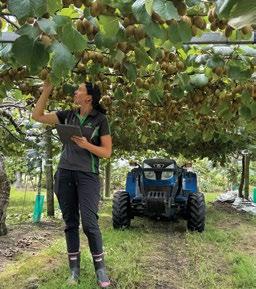
“I CERTAINLY NOTICE THAT OUR CLIENTS PREFER TO DEAL WITH NEW ZEALAND. THERE IS A CONNECTION THERE AND WE DEFINITELY VALUE THOSE STRONG RELATIONSHIPS.”

NICOLE METZGER, MANAGING DIRECTOR AT SOUTH SEAS EXPORTS, WHICH HAS 20 YEARS OF EXPERIENCE IN THE REGION
“The Pacific is sometimes overlooked but I think it’s a great export opportunity for growers, for a lot of crops, it’s not just potatoes and onions. It’s cabbages, leeks and witloof… Small lines but it adds up. It’s a nice little additional outlet for those growers who aren’t supplying the supermarkets.”
Overall New Zealand exported $122 million worth of vegetables, fruit and preparations in 2023 (FOB value) to the Pacific, while imports from the region totalled $33 million.


Registrations now open Recognised Seasonal Employers and Horticulture Conferences 2024 28-30 August, Mercury Baypark, Mount Maunganui Early bird pricing available for a limited time Register at: www.hortnzevents.co.nz NZ GROWER : MAY 2024 27

Pacific Trade Invest New Zealand (PTI NZ) Trade Commissioner Glynis Miller says interventions by PTI NZ, PHAMA Plus (Pacific Horticultural and Agricultural Market Access Plus) and PACER Plus (Pacific Agreement on Closer Economic Relations Plus) unlock some of the technical barriers experienced by Pacific Island growers, and go some way to address the trade balance between New Zealand and the Pacific Island countries.
“New Zealand’s horticulture industry can do a lot for the Pacific, beginning with being active investors,” says Glynis. “New Zealand’s innovation in horticulture is outstanding. Concerted efforts should be made to share best practices with the Pacific region. Transferring one percent of New Zealand’s technical expertise in agri farming can be a game changer.”
New Zealand expertise from the private sector is already an element in some horticultural developments – such as help in extending island-based co-operatives in vanilla, honey and cacao production.
Plant & Food Research is active in the Pacific, including a five-year project funded by New Zealand Aid Programme to increase the resilience of the Tongan vanilla industry, with a target to increase production and improve quality. The Tauranga-based company Heilala Vanilla is one of the two biggest Tongan vanilla exporters and a key collaborator in this project.
And Glynis notes that the success story of Niue honey –voted the best in the world at an international honey expo in London, “is in some way attributable to expat New Zealand staff at the operation.”
New Zealand also supports Pacific growers by reducing trade barriers. There are practically no tariffs on Pacific Island horticulture imports into New Zealand, however New Zealand maintains non-tariff measures, including those to manage biosecurity risks such as fruit fly.
YOUR INDUSTRY
28 NZ GROWER : MAY 2024
Pacific Trade Invest New Zealand (PTI NZ) Trade Commissioner Glynis Miller (centre) visiting a taro crop with a group of Fijian growers who are part of the AgriRugby academy – being coached rugby half-time, and concurrently learning agriculture and financial literacy – an initiative set up by Fijian rugby great Seremaia Bai. Photo courtesy PTI NZ

Traditional Pacific crops have a rapidly developing export market, such as gluten free flours from breadfruit, banana, manioc and cassava, and frozen and dried taro. Other investments in export crops are targeting global specialty markets where Pacific conditions may provide a unique benefit, such as vanilla, cocoa and coffee.
Other tropical crops such as pineapples, mangoes and cut flowers face competition from New Zealand’s usual suppliers such as from Queensland.
New Zealand’s horticulture industry can do a lot for the Pacific, beginning with being active investors
“There are 152 existing pathways for fresh fruit, root crops, vegetables, cut flowers, foliage, etc.,” Glynis continues, “yet less than 50 percent of these are utilised. PTI NZ and its partners are currently working on a project to look at opportunities for Pacific growers in the New Zealand market.”
Ritesh Gosai, business development support at PTI NZ, says increasing domestic food supply and reducing reliance on imports can go hand in hand with developing export markets like New Zealand.
“Developing a robust domestic food supply often involves improving farming practices, infrastructure, and adherence to quality standards. These improvements can enhance the competitiveness of island nations’ agricultural

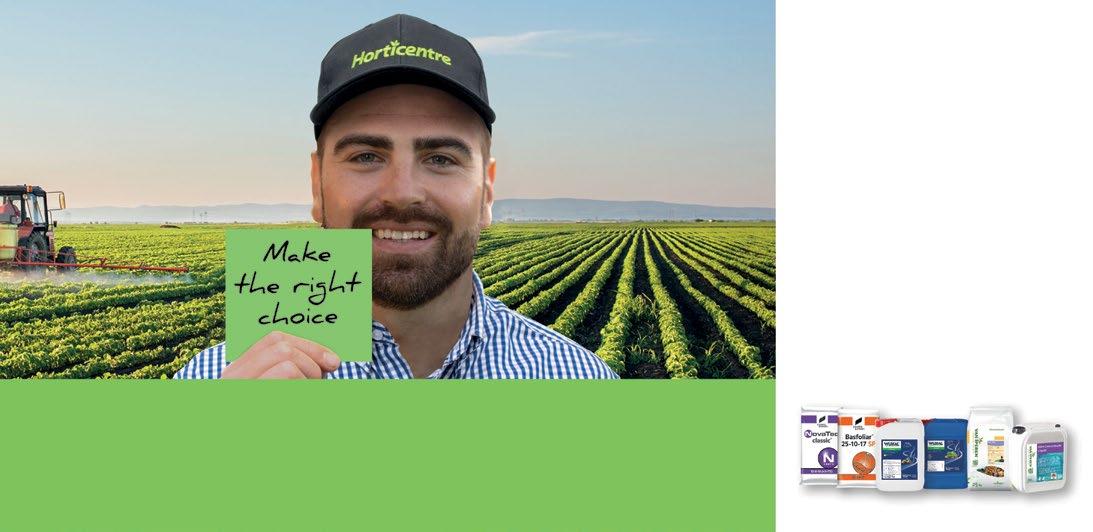
 A grower in the Solomon Islands, part of a women-led growing co-operative that supplies cacao to New Zealand-based The Cacao Ambassador. Photo courtesy PTI NZ
A grower in the Solomon Islands, part of a women-led growing co-operative that supplies cacao to New Zealand-based The Cacao Ambassador. Photo courtesy PTI NZ
NZ GROWER : MAY 2024 29
BLUE PACIFIC EXPORTS
3.5 MILLION PEOPLE LIVE IN 18 COUNTRIES IN THE PACIFIC OCEAN*
$122 MILLION IN EXPORT REVENUE FOB IN 2023 FROM THE PACIFIC ISLAND NATIONS**
20% FRUIT
80% VEGETABLES
10.3 MILLION PEOPLE LIVE IN PAPUA NEW GUINEA*
THE PACIFIC ISLAND NATIONS ARE A LARGER MARKETPLACE FOR NEW ZEALAND HORTICULTURE THAN HONG KONG
*These numbers exclude tourists, which make up a significant additional population of consumers in the islands. **Pacific Island Forum countries plus American Samoa but excluding Australia and New Zealand.
products in international markets. By demonstrating the ability to produce high-quality agricultural products, island nations can attract interest from importing countries like New Zealand, leading to mutually beneficial trade relationships such as trade pathways.”
Freight costs are one of the top three barriers to export faced by Pacific businesses, and this situation was exacerbated by the disruptions to shipping created by Covid-19. PTI developed a freight assistance package to support Pacific exporters by reducing the cost of accessing international markets in a post Covid-19 recovery phase.
Ritesh says New Zealand and Pacific Island nations can explore collaborative initiatives to optimise shipping and air freight services, such as joint ventures, public-private partnerships, or regional agreements aimed at improving connectivity and reducing costs.
LEADING EXPORT MARKET FOR OUR FRESH POTATOES
Fiji, which on its own is New Zealand’s 17th largest export market, has long been New Zealand’s leading export market for fresh potatoes. Potatoes
NZ chief executive Kate Trufitt says closer ties with the country is high on her agenda.
“Potatoes NZ has done significant work with Fiji in regards to their potato production offering, assistance and expertise.
“As a new chief executive since August 2023, I am working to re-establish relationships with Fiji, to develop programmes that will benefit exports as well as from a food security perspective. There is ongoing work to be done in this space.”
For more information about potato exports, see page 55.
YOUR INDUSTRY
30 NZ GROWER : MAY 2024
NEW ZEALAND’S FRESH FRUIT AND VEGETABLE EXPORTS TO THE PACIFIC
TOP 10 PACIFIC EXPORT DESTINATIONS FOR NEW ZEALAND HORTICULTURE IN 2023 (EXPORT REVENUE FOB $NZ)

NEW ZEALAND’S LARGEST PACIFIC TRADING PARTNER
$60 MILLION EXPORTS
NEW ZEALAND’S FRUIT AND VEGETABLES FOB EXPORT REVENUE (NZD) TO FIJI IN 2023
85% VEGETABLES
ALMOST HALF OF OUR EXPORTS TO FIJI IS POTATOES, FOLLOWED BY ONIONS AND CARROTS
$27 MILLION IMPORTS
NEW ZEALAND IS FIJI’S SECOND LARGEST CROP AND LIVESTOCK MARKET AFTER THE USA
Source: Fiji 2022 Agriculture Annual Trade Report, Crop & Livestock Commodities/Products (Fresh/Chilled and Value Added)
INDUSTRY
YOUR
EXPORTS TO AUSTRALIA EXPORTS TO NEW ZEALAND IMPORTS FROM AUSTRALIA IMPORTS FROM NEW ZEALAND EXPORTS TO USA FIJI 23% 16% 15% 9% 7% Fiji French
New
Polynesia
Caledonia Samoa inc. American
Samoa Cook Islands Papua New Guinea
Tonga
Vanuatu
Kiribati
0 10 20 30 40 50 60 $millions
Solomon Islands
NZ GROWER : MAY 2024 31
NO SILVER BULLET WITH GMO AND GENE EDITING
This article reflects my personal point of view and is not associated in any way with my industry involvements.
I have followed the development of genetic engineering (GE), genetically modified organisms (GMO), and gene editing technologies since the mid-1990s. Often Iʼve asked myself how could this technology benefit New Zealand growers, our food security, our economic and our environmental resilience. But I just can’t see any opportunity that can balance up what we have to lose. Consider the fact that we are an island nation of premium food producers, and our position in the world as a food producing nation with the ability to feed upwards of 40 million people.
I believe New Zealand needs to position itself as a producer of high-quality food with the story of provenance and integrity behind it. We are not large-scale producers of low value corn and soybeans, this is done by the North Americans, Brazil etc. We need to be market driven with the approach to our food production systems. Commercial production of GMO food crops in New Zealand is very unlikely in the near future, as there are no crops on the horizon that may benefit New Zealand growers. However, the perception that crops may be field trialled or even seed lines contaminated with GMO pollen would raise alarm bells.
Our marketers and food manufacturers will soon tell you they have no demand for GMO produced crops. There is enough concern around GMO for them to avoid purchasing these crops. Our vegetable and arable seed industry has a huge benefit from raising GMO-free seed lines. The cost benefit of adopting GMO crops versus remaining GMO free is economically a no brainer. We have so much to lose and very little to gain if we take the GMO path.
The silver bullet or the Holy Grail is just not there. We are led to believe by the proponents of this technology that all manner of adversities that we as growers face can easily be engineered, sorted, fixed and sold to us in order to produce reliable crops. As the GMO technology
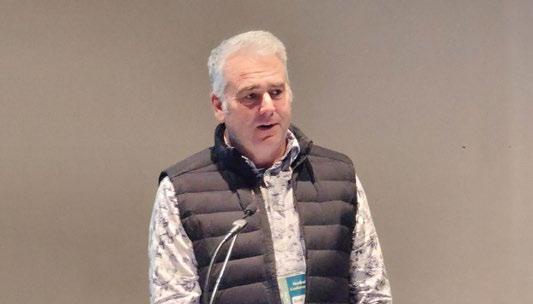
is owned by only a few multinationals and currently our seed lines that we grow are owned by many different companies, it will be impossible to adopt this technology across a wide range of vegetable lines. For instance, the approximately 20 varieties of onion seed we grow in New Zealand along with the wide range of potato seed lines, brassicas and lettuces, just to name a few, will not benefit from this technology. And if grown alongside a handful of GMO lines, these current crops could be easily exposed to pollen and cross contamination.
Our vegetable and arable seed industry has a huge benefit from raising GMO-free seed lines. The cost benefit of adopting GMO crops versus remaining GMO free is economically a no brainer
Keep it in the lab. The proposed weakening of our current rules under the Hazardous Substances and New Organisms Act which were designed to protect our country from GMO and gene editing contamination would spell an end to all the advantages we currently have. If field trials and release occur there will be no turning back. It is disappointing to see the gene editing story being sold as a reliable, repeatable technology. In many parts of the world this is still considered GMO technology, with all the vagaries and unknowns that come with it.
‘’Proceed with caution’’ to me means keep it in the lab, no field trials, no general release.
YOUR INDUSTRY
Scott Lawson : Lawson’s True Earth berries
32 NZ GROWER : MAY 2024
Grower Scott Lawson received a Vegetables NZ industry service award in 2023

us your nominations for

Industry Awards
HortNZ is calling for nominations for its 2024 Awards to be presented at the Horticulture Conference Gala Dinner.
HortNZ will present up to one award in each of the following categories each year.
BLEDISLOE CUP
Awarded for an outstanding and meritorious contribution to the New Zealand horticulture industry.
PRESIDENT’S TROPHY
To celebrate and develop inspiring leadership within the horticulture industry.
INDUSTRY SERVICE AWARD
To recognise people with long and dedicated service in a supplier or service role (not a grower) that have worked beyond the call of duty for the betterment of the horticulture industry.
ENVIRONMENTAL AWARD
To recognise a person, or organisation, that has developed and implemented a sustainable environmental project, with identifiable benefits.
HORTNZ LIFE MEMBER
To recognise growers with long and dedicated service as office holders of HortNZ and/or an affiliated Product Group or affiliated Grower Association.
Full criteria for the above awards are available on the HortNZ website or can be requested from the Board Secretary by emailing admin@hortnz.co.nz
Who can make nominations?
• Any grower member of HortNZ, an affiliated Product Group or an affiliated Grower Association can make nominations.
How do I nominate someone?
• Complete the nomination form on the HortNZ website www.hortnz.co.nz/news-events-andmedia/events/industry-awards/. If you have any questions about making a nomination you can email admin@hortnz.co.nz or call 0508 467 869
When will the awards be presented?
•At the 2024 Horticulture Conference Gala Dinner on Thursday 29 August 2024 at Mercury BayPark, Mt Maunganui
When do nominations close?
• Nominations must be submitted via the online form on the HortNZ website by 5.00pm on Tuesday, 18 June 2024.
Send us your nominations now!
Send
202
the
4 Horticulture
ROADING A CHALLENGE BUT STILL BEST OPTION FOR FREIGHTING FOOD
Kristine Walsh

Steve and Jane Weatherell founded Freshways (formerly Weatherell) Transport 30 years ago and fresh produce has always been their primary focus
Thirty years after founding their Gisborne-based trucking company, Steve and Jane Weatherell remain focused on making sure food always gets through.
Like a fleet of giant overnight couriers, a Gisborne trucking company gets fragile produce to market in uber-fast time, but there are challenges in doing so.
“The reality is the roads out of our region are always going to be vulnerable, especially with the increasing number of big weather events, and there’s no way around that,” says Freshways (formerly Weatherell) Transport owner Steve Weatherell.
“But though we’ve experimented with different transport options, road always comes out on top, so we just work with what we’ve got.”
This year marks the 30th anniversary since Steve and his wife Jane founded their company, and food – particularly fresh produce – has always been their primary focus.
That’s been a big strength for an outfit operating out of one of the most prolific food-producing regions in the country.

With Steve Weatherell (right), Gisborne branch manager Paul Barker (left) says: “We’re proud of what we do but there are challenges, like the roads, and keeping that cool-chain intact, as with produce there is no room for error.”
On the flip side, time is of the essence: a driver can’t park up for a couple of days while an issue with roading gets sorted.
“That was a big problem immediately after Cyclone Gabrielle (February 2023) … the roads were closed both north and south even though we knew we could get through,” says Steve. “So we had to impress upon the authorities that it did not just stop food from getting out, it also stopped it from getting in, and we had a community that needed feeding.”
The impact of Cyclone Gabrielle was just the latest in a series of impacts Steve has witnessed since 1994 when he founded Freshways with a handful of trucks, building it up to a leading provider with six depots nationwide, over 150 staff (plus contract workers), and more than 100 trucks (plus 20 owner-drivers) clocking up over one million kilometres every month of the year.
Being based in Gisborne means their drivers are travelling some of the most vulnerable roads in the country.
“The moment our drivers get over the Wharerātā Ranges and through to Napier in the south or through the Waioeka Gorge to the north, the journey gets a whole lot smoother,” Steve says.
YOUR INDUSTRY
34 NZ GROWER : MAY 2024
“And it’s even more marked in the South Island. All the damage inflicted by sub-standard roading on our trucks, trailers and refrigeration equipment just doesn’t happen there. It’s like night and day.”
Over the years Steve has supported other transport options in an effort to get the best results for producers of fresh fruit, vegetables and meat.
Before the Gisborne to Napier rail line was mothballed – most likely for good – he tried that, but the scheduling didn’t suit clients who often didn’t know what they had to shift until the day of transport.
Then he got behind Eastland Port’s ‘blue highway’ trial of coastal shipping, but that didn’t work either.
“Because of the challenges of Poverty Bay (Tūranganuia-Kiwa) the ships were stuck offshore every time there was bad weather, and you just can’t have that with fresh produce,” he says.
“Clients were having to organise trucking on the fly to get produce off the wharf and on the road, so there was some resistance.”
So it was back on the road which, says Steve, has challenges of its own.

Greenhouses
“built stronger to last longer”

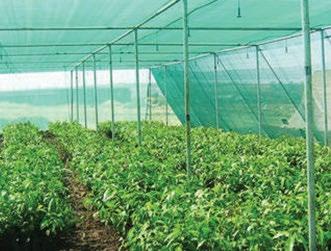
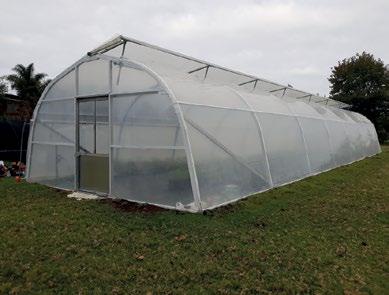
Redpath Greenhouses and Shadehouses, Manufacturing and suppling the industry for over 35years. Designs to suit your business and growing needs from the very large to very small. Designed, Manufactured, Delivered and installed on your site. Council plans and application work included. All buildings provided with manufacturer’s warranty and our construction crews are based nationwide for efficient and speedy assembly and after-sales service. Check out our website below for the full range of buildings, greenhouse films and fabrics.
Freshways forklift operator Ryan Anderson (left) and driver Tyrone Taukamo
www.redpath.co.nz FREE PH 0508 733 728
PROPAGATION FLAT ROOF SHADE HOUSES VEGETABLE PRODUCTION NZ GROWER : MAY 2024 35
YOUR INDUSTRY
“All we want to see is good, practical work done to make sure drivers have a safe, consistent pathway to and from our region.
“Nobody is interested in fancy flyovers and the like. We just want quality, well-maintained roading.”
Even given the challenges with roading, Freshways manages to keep a big operation on the road.
Seven days a week the drivers are looping the North Island – from Gisborne down to Wellington, up to Auckland and home (or the other way around).
And most days the company has around half-a-dozen trailers on the inter-island ferries – each way – to get fresh produce to the South Island.
“People don’t believe we can leave Gisborne late in the afternoon and have the goods on the shelves in Invercargill by the following day, but that’s what you need to do when working with fresh produce.
“It is critical to all our clients that they get maximum shelf life and – within the boundaries of legal and safety issues – we pull out all the stops to do that for them.”
Steve’s commitment to carting produce was the very foundation of his business.
We had to impress upon the authorities that it did not just stop food from getting out, it also stopped it from getting in
A former owner-driver himself, while living in the Bay of Plenty in the early 1990s he drove the Gisborne run for Freightways.
“Other drivers said they didn’t want to deal with ’that bloody gorge’ on the north side and the hills to the south, but I thought it was better than being stuck in traffic all day, so I just got into it.”
Steve continued with the run when it was taken over by Mainfreight but found growers were more interested in connecting with him than the company, so he formed his own.
“By that time the Kaiti freezing works had closed, along with the local pet food factory, so a lot of workers moved into horticulture and the industry was getting bigger and bigger.
“Some local growers had asked if I’d consider going out on my own, so in October 1994 we talked about it over a few beers at the Hika (Waerenga-a-Hika Hotel, now Bushmere Arms), and the next day I was in business.”

In charge of dispatch, TJ Singh manages a hectic work programme of truck movements, spanning the length and breadth of the country
While roading has presented challenges over the years, it’s not the only hurdle Steve and Jane have tackled.
“Our business is fresh and frozen produce so we’re always going to get through one way or another … people need food.
“There certainly were big costs to face after the cyclones. Road closures meant we had to drive south before we could go north and that required more trucks and more drivers.
“Our biggest hit, though, came later in the year when it just wouldn’t stop raining. That hindered growers’ ability to produce and pick crops so, from August to October, volumes were way down and we had a lot of trucks coming into Gisborne with loads then having to go out empty. That was a huge cost to us but we couldn’t not do those in-bound loads. Our community needs food.”
Continuing rain affected the roads too, but Steve says things are looking better after a dry summer.
“They had a hell of a task to deal with all the weatherrelated damage but if you look at it now, particularly in the Waioeka Gorge, there are big tracts where they’ve dug it out, rebuilt it and laid new seal,” says Steve.
“Our drivers can really feel the difference so what we need to see is more of that, where and when it is needed.”
Steve Weatherell qualified for his Gold Card this year and while he doesn’t know what he’d do if he actually retired, rebranding as Freshways is part of the move towards that.
“Jane and I thought that, at some stage, it would be odd to have our name on all these trucks, so that’s what drove the rebranding,” he says.
“Plus, it really sums up what we do finding ways to get fresh produce to market in good time and in good condition.”
36 NZ GROWER : MAY 2024
SEED GROWERS SEEK NEW PASTURES

Vegetable seeds produced in New Zealand play a crucial role in global food production, and now the thriving industry that’s grown in Canterbury over the past 30 years is looking to expand to other parts of the country.
More than sixty percent of the radish seed used worldwide every year is produced in New Zealand, along with forty percent of the carrot seed, grown by farmers like David Birkett on the fertile soils of Leeston, 30km southwest of Christchurch.
David’s been growing vegetable seed for about 25 years.
“We were one of the first to grow radish in the district and it’s developed pretty rapidly from a few crops of radish being multiplied to now New Zealand being one of the main players in crops like radish and carrots.”
Canterbury specialises in multiplying seed for mainly European customers, taking a few kilos of valuable seed and turning it into hundreds of kilos which are shipped back to Europe.
“They can get production down here during their Northern Hemisphere winter, which means they can actually speed up breeding programmes because you can get two crops grown in one year,” says David.
“It also means some of those big companies don’t have to carry as much inventory over. They can have inventory in the Southern Hemisphere being grown as well as the Northern Hemisphere, which spreads their cost of production and the amount of stock they have on hand.”
He has grown radish, red beet, cabbage and corn salad seed, as well peas and beans, both for seed and for processing, and grass seed, wheat and barley.
No two seasons are the same for seed producers, with both climate as well as markets sure to fluctuate year to year
“Having that range of crops does give us some resilience as well, because those crops are at different stages during the year and they are into different markets as well. If we have a weather event it might only affect four of the eight crops rather than all of them and if the market changes, you hope it only changes for some of the crops you’re growing, not all of them.”
The round red radish seed that David harvested in early April is typical of the crops he grows. He sowed less than1kg/ha and is targeting a yield of 850kg/ha.
Tony Benny
NZ GROWER : MAY 2024 37
Seed grower David Birkett harvesting on the fertile soils of Leeston

“What amazes me is you look at all the seeds and you think how many radishes it must grow and it sort of gives you an idea of the global population and puts it in perspective, just how much food the world must eat and this is just one paddock.”
David is chairman of Federated Farmers arable industry group, and he says the potential issue that concerns him most is biosecurity, making sure both seeds coming into New Zealand as well as those being exported are absolutely free from any pest or disease.
“If we had a disease coming in and it affected the radish, you couldn’t export it and that would be the industry gone, so I think biosecurity would probably be number one.”
He lists access to water as crucial too, as most seed crops are grown under irrigation.
“It doesn’t matter what denomination a minister has come from, having a robust and good agricultural system in New Zealand is vital for the country. If agriculture’s not performing, then New Zealand’s not performing and that’s really the key message we need to be sending to the government.”
NEW ZEALAND GROWS
60%+ OF THE RADISH SEED USED WORLD WIDE
40%+ OF THE CARROT SEED USED WORLD WIDE
Closer to home David is one of a number of growers who have worked together to develop a crop isolation system to avoid outcrosses between the different varieties of vegetable seeds grown around Canterbury, with different districts reserved for each.
“These round red radishes are all grown here in Ellesmere. If you go over to Irwell (about 10km away), they grow French breakfast which are slightly longer ones.
“It’s a good thing we’ve been able to do that because it shows the industry is able to work together, but it also makes sure we have some protection from outcrossing for the industry. If there are outcrosses found in the seed line, then the line is simply destroyed, it’s no use to anyone, so it’s pretty important we do get it right.”
While compliance with the system isn’t compulsory, David says it’s working well, with peer pressure between seed companies and between growers and companies making sure everyone behaves.
But finding enough space to grow the diverse range of crops to which Canterbury is suited is becoming challenging. As well as needing to keep similar varieties apart for the sake of seed purity, crop rotation has to be accommodated too; peas need seven years between crops in the same ground to keep on top of root disease, and carrots need eight.
“The industry is Canterbury-centric but we’re getting pretty full for a lot of crops from an isolation point of view so I can see places like Hawke’s Bay, Wairarapa and Southland, if it keeps getting warmer, might be growing more of the crops we see in Canterbury.”
That couldn’t happen overnight without the required infrastructure, including seed drying and processing plants, but David reckons it is a realistic option. “That’s the stage we’re at now, looking at what infrastructure do we need elsewhere other than Canterbury to grow the industry a little bit more.”
It is also likely, David says, that land use will evolve in Canterbury and more space could be made for seed production in a region where the rapid expansion of dairy farming has transformed the countryside.
YOUR INDUSTRY
38 NZ GROWER : MAY 2024
David Birkett has been growing vegetable seed for about 25 years
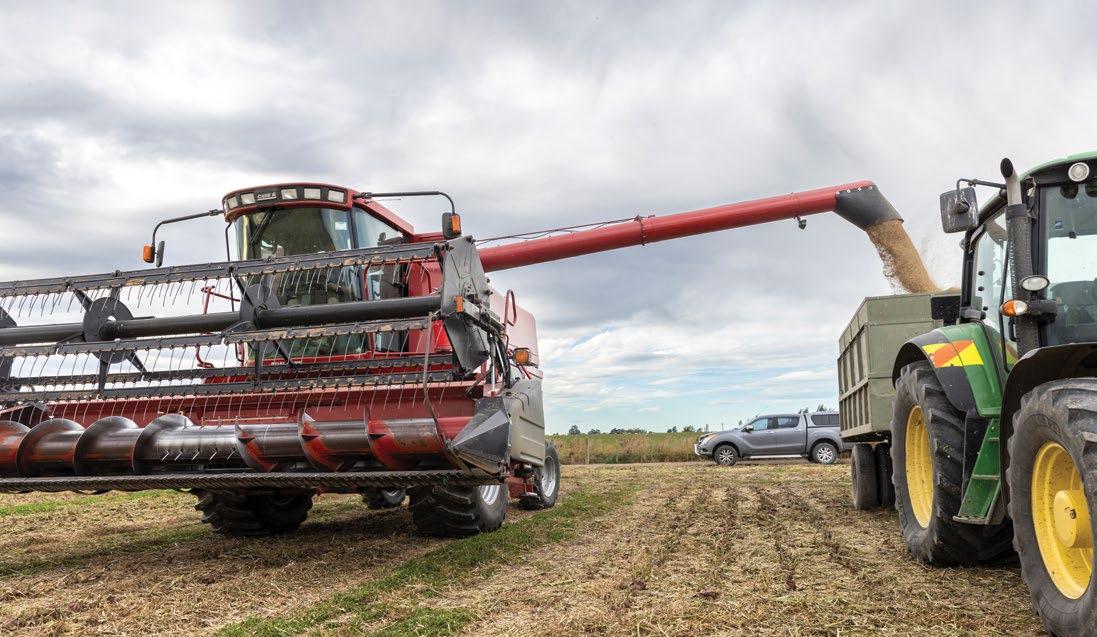
“I think we’re already starting to see it. Some dairy farmers are starting to grow some of these high value crops on their dairy platform and that makes perfect sense. They’ve got the irrigation, the soils are in good nick, given it’s coming out of pasture, and I can see there’ll be more integration between sectors with dairy growing some more crops.”
A return to something closer to the mixed farming model that existed in Canterbury a generation or so ago would make a lot of sense, says David.
“I think for New Zealand Ag Inc it’s a good idea to have some variation of income. If New Zealand was just one dairy farm or one sheep and beef farm we’d be in trouble when those markets collapse, but by having horticulture going really well and arable and all the other sectors as well, while they might be smaller compared to the scale of dairy and sheep and beef, they are still important sectors and do provide that level of resilience that you need in an economy.”
No two seasons are the same for seed producers, with both climate as well as markets sure to fluctuate year to year. Last year there were more contracts available than growers to fill them, but this year the opposite seems to be true.
“It can swing pretty quickly,” David says, so growers have to be at the top of their game. “The companies want a good product and reliable production. They look for growers who have performed year in year out, who they know will do a good job, have the harvesting capacity, the driers for the seed. Those things help determine who can get contracts.”


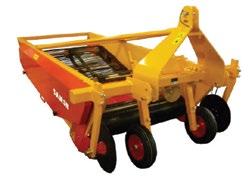


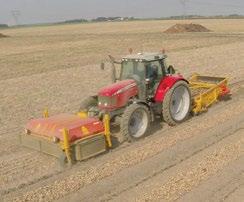
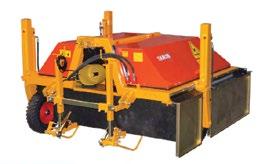
Your Link to the World’s best Farm Machinery SAMON ONION TOPPERS AND HARVESTERS. Reliable Machinery and Parts Supply FOR ENQUIRIES 07-889-5853 agro.eq@outlook.com Morrinsville NZ GROWER : MAY 2024 39
Finding enough space to grow vegetable seed in Canterbury is becoming challenging
INVESTING IN OUR TRADE PARTNERS: INDONESIA’S ONION GROWERS
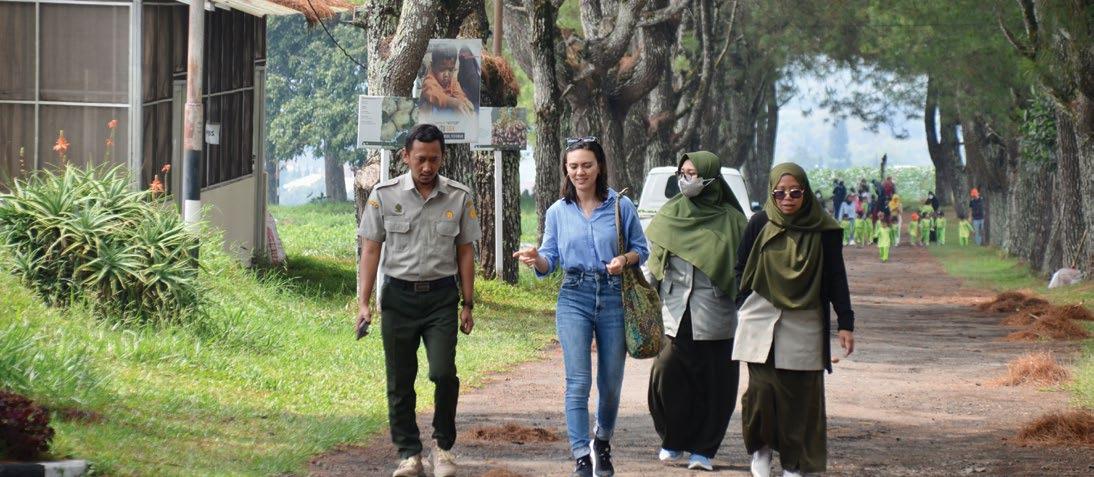
Food security is not just about feeding New Zealand’s five million. It’s a global issue and New Zealand is a small but noteworthy part of the solution. A recent report showed that 118 countries – home to almost half the world’s population – do not have sufficient agricultural land to produce enough food to feed their populations.
Southeast Asia is a prime case in point – not just Singapore with its high population density, but also Indonesia, the largest member of ASEAN (the Association of Southeast Asian Nations).
For several years Onions NZ has worked on closer cooperation with the Ministry of Agriculture in Indonesia.
“Investing in our trade partners means a lot to us, and supporting local farmers and food security is a part of that,” says Kazi Talaska, market access and development manager at Onions NZ.
In a recently signed agreement, the New Zealand onion sector is supporting three years of research and extension for Indonesian growers, particularly for shallots; a strategic commodity that is widely grown, consumed, and has a high economic value for Indonesia. Improving crop yields is an important way to increase food security.
Annually, the cooperation agreement sees approximately NZD $30,000 of investment, which is partly funded by the Ministry for Primary Industries’ Sustainable Food and Fibre Futures (SFF Futures).
The efforts seem to have benefited New Zealand growers directly, too. Our trade with the Southeast Asia market has grown substantially, the sector as a whole has thus observed increasingly good payment terms and longer exporting windows.
Last year New Zealand exported 35,000 tonnes of onions at a value of NZD $35 million, making Indonesia our single largest market for onions, accounting for 20 percent of exports. The AANZFTA (ASEAN-AustraliaNew Zealand Free Trade Agreement) also continues to open doors and provide that opportunity for growth.
“In general terms, New Zealand remains a relatively small player, with volumes that would not easily flood a market. In Indonesia, the preferred allium is shallots and garlic, and New Zealand plays a smaller role in supplying the western brown onion used for food service and other international cuisines.”
“That makes us a great partner to support Indonesian growers. While we are trading a specific brown onion product, the technical expertise in allium growing can be transferred to the shallot or garlic space that has far wider implications for Indonesia food security.”
YOUR INDUSTRY
NZGrower staff
40 NZ GROWER : MAY 2024
Kazi Talaska, market access and development manager at Onions NZ, speaks with Indonesian agriculture officials during a visit
The strong relationship also forms a basis to react to non-tariff barriers. The hope is that this better equips us to have conversations on resolving these issues today and in the future.
“New Zealand typically pushes for rules-based trade, we recognise that the western based perception of how trade takes place is at times limited. Not all countries operate the same way, and we need to adapt our strategies and ways of doing business accordingly.”
Minister Peters’ visit in March to ASEAN countries was really positive for the onion sector, Kazi says. More investment in these markets and government relations is welcomed.
“Trade also goes both ways,” she adds. “We don’t produce everything that the New Zealand market needs, so those strong relationships mean security for all parties. Global trade is a mechanism for countries to gain what they need more of or don’t produce; New Zealand is no exception.”
The hope is that the cooperation agreement and the relationships developed will support further work with the Indonesian Ministry of Agriculture and the New Zealand horticulture sector, Kazi says.


In Indonesia shallots are a widely grown and high value domestic crop, whereas brown onions imported from New Zealand are used in food service and other cuisines
“Knowledge transfer between countries is something we are actively working on, and are in contact with our adjacent horticulture sectors about working together in markets for this.”

PLANT FOR SUCCESS
Titan
With maturity similar to PLK types, Titan is very uniform and has the ability to produce excellent yields due to its strong vigour. With good skin retention and three good skins, this onion has excellent shipping and long storage capabilities.
Nisu
Looking for a small cabbage? Nisu is suitable for year round production and perfectly sized to fit in the new crate sizes. Approx. 2-2.5kg in winter and up to 3kg in summer. Early maturing, small-medium drumhead, glossy leaves, great eating. Holds well.
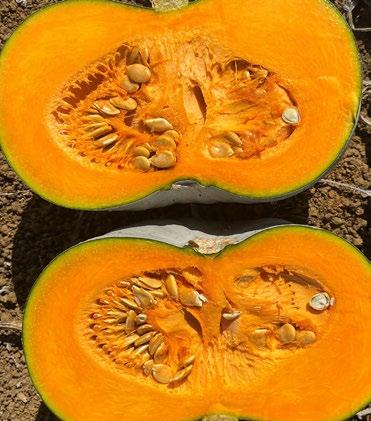
Baron
New to our pumpkin range Baron is early maturing, averages 3.5-4kg, has a small seed cavity, and vibrant orange flesh. Skin is blemish free. Maturity between Pacific King and Invincible. Long storage.
0800 Lefroy (533 769) Call us today about our range www.lefroyvalley.co.nz
NZ GROWER : MAY 2024 41
THE LITTLE GUYS – STARTING OUT AS A COMMERCIAL GROWER
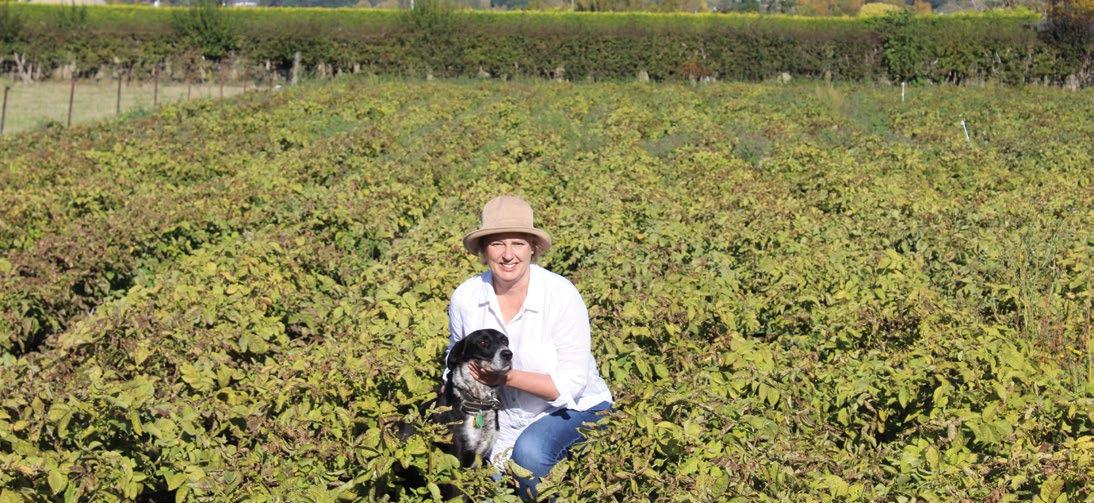
It started as a conversation over planting spuds in the vege garden in November and ended with a hectare in Agria and Nadine potatoes on the Taieri Plain near Dunedin a couple of months later. Just like that, NZGrower writer KAREN TREBILCOCK has become a commercial grower.
Well, if Jeremy Clarkson could do it, why couldn’t we? It wasn’t as if the sheep which usually grazed the paddock were returning much money. And potatoes in the supermarket were expensive.
A planter was rescued from a friend’s paddock, a local dairy farmer had an old lifter but it needed a lot of TLC, and our neighbour had the moulding boards and tales of making thousands of dollars in a weekend from potatoes in the 1980s.
We were set. We bought an irrigation gun online for $150. The potatoes grew but we had nowhere to sell them.
Shut out from our closest farmers’ market by those already supplying potatoes to it for years, and knowing the local supermarkets wouldn’t take them, it was going to be a roadside stall before we were saved by local greengrocer Mosgiel Garden Fresh.
Our price point for the freshly dug, spray free, unwashed, loose Agria potatoes was $1.20/kg. The store sold them at $1.99. The supermarket around the corner sold washed, white, loose potatoes for $3.49. A facebook post on the local community noticeboard showing the different retail prices got 300 likes or loves for our potatoes in the first 24 hours.
Comments on it included how people loved our spuds and how the shop staff were fantastic. A couple of days later the supermarket raised their price to $3.99.
One of our potatoes, we called him Mr Potato Man because that’s what he looked like, went up for auction on Trade Me with the money going to the charity New Zealand Food Network.
The Taieri used to grow vegetables on a large scale by generational Chinese market gardeners and on a smaller scale by people like us. Our neighbours aged in their seventies and eighties remember earning pocket money by picking spuds after school. There is talk of a study once showing it was the best place in New Zealand to grow carrots.
But these days are different. We no longer eat meat and three vege meals twice a day. Potatoes are not even viewed by everyone as veges but instead as a carbohydrate which makes you put on weight.
YOUR INDUSTRY
GROWER FEATURE 42 NZ GROWER : MAY 2024
Karen Trebilcock in the Nadine potato patch on the Taieri near Dunedin with her sheep dog Ruby who’s wondering when the sheep are coming back
Plus they now compete with pasta, noodles, rice and quinoa. Most fish and chip shops don’t hand cut their own chips. Everyone complains how expensive food is, but few stray from the duopoly’s supermarket shelves, especially for an unwashed, unbagged spud.
Yes, we are going to pay the grower levies and will look at becoming NZGAP (Good Agricultural Practice) certified, although can we point out in the meat industry, our yearly audit and certification is free.
But we doubt we will ever supply the major supermarkets, unless things change. Our closest produce hubs for Foodstuffs and Woolworths NZ are in Christchurch –the only ones in the South Island. We would have to pay the freight to get our potatoes there. And then they would be in a truck again going past us to get to our local supermarkets and those further south. We’re not growing potatoes to keep trucks on our roads.
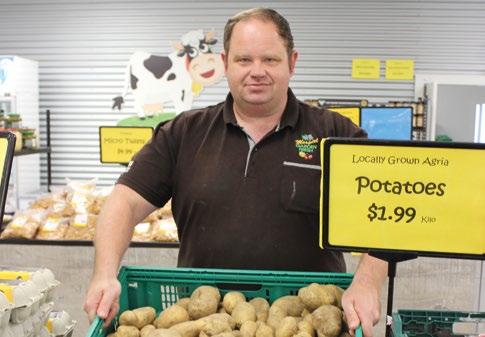
RETURN OF THE LOCAL GREENGROCER?
Will and Fiona Leith’s Mosgiel Garden Fresh on the main street of Mosgiel sells Trebilcocksʼ potatoes.
They opened their store in August 2022 as they saw space in the market for better priced, better quality produce, Will says.
Apart from potatoes, they sell pumpkins, lettuce, strawberries, swedes and beetroot grown locally, as well as honey, and are keen to add more produce. The rest of what they sell is from MG in Dunedin which mostly comes from Oamaru growers.
“Some of our local growers tell us the price they want to sell their produce for in the store and we’re happy with that. The others, like with the potatoes, we suggested the price. We do well out of it, and we want to share the money around.
“If our growers aren’t doing well, then we’ll have nothing to sell.”
So it’s been fun. We’ve learnt lots, from marketing to how to straighten old, buckled axles. It’s weird thinking the potatoes we have grown and handpicked are on other people’s dinner plates, even though we’ve been doing the same with sheep and beef for years.
It feels there is more of a connection, maybe because we know it’s our community that is (hopefully) enjoying them. And I think that’s really why we’re doing it.





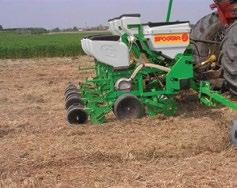
Planting Growing
www.transplantsystems.co.nz admin@transplantsystems.com
PLANTING MULCHING STRIP TILLAGE SEEDING Seeding
Transplant Systems Ltd
The lifter that the Trebilcocks borrowed, after a few minor repairs, is ready for the Nadine crop
Owner Will Leith wants more local produce at Mosgiel Garden Fresh
NZ GROWER : MAY 2024 43
YOUR INDUSTRY
KEEPING THE LOCAL IN THE NATIONAL SUPPLY CHAIN?
Karen Trebilcock
While supermarket consumers say they love to buy local, modern supply chain infrastructure works most efficiently with large volumes of product – not small-scale farmers. Commercial vegetable growing has consolidated, with an estimated 115 businesses managing 75% of vegetable growing area.
Foodstuffs North Island head of merchandise, produce and butchery Brigit Corson says Foodstuffs North and South Islands tries to support local growers.
“It makes good sense for our stores, our communities and our customers. Customers really like knowing if they’re eating Gisborne mandarins or Kumeū strawberries as it gives a sense of connection to the produce, especially if you live in Gissy or Kumeū.”
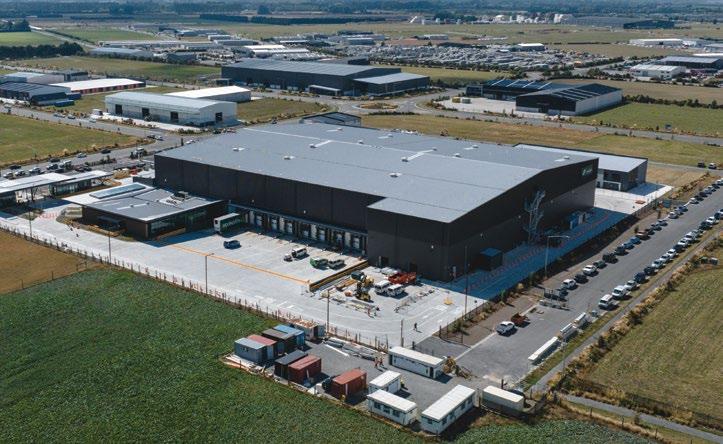
Woolworths NZ CFDC Woolworths NZ’s $99 million Christchurch
(CFDC) which opened at
“Every Foodstuffs store is 100 percent locally owned and operated and our teams want to support other local businesses. Customers love it and it makes good sense for the community too,” Brigit says.
To supply Foodstuffs, growers must meet compliance requirements including NZGAP (Good Agricultural Practice) and social standards.
It’s only other distribution centre (AFDC) is at Wiri near Auckland. Again growers pay for the freight to these hubs, but a spokesperson for Woolworths NZ says this is taken into consideration when agreeing on pricing. They don’t accept produce directly into store.
Customers really like knowing if they’re eating Gisborne mandarins or Kumeū strawberries
Although Foodstuffs fresh produce hubs are only in Auckland, Palmerston North, Wellington and Christchurch, with growers paying the freight to these hubs, some growers do supply directly into store, she says.
“Growers work directly with us for a range of reasons. Typically, they enjoy the fact we distribute efficiently across the islands we operate in, ensuring maximum freshness when their product reaches our stores.
“Because of our supply chain infrastructure, there’s efficiencies for suppliers, especially when they’re providing us with large volumes of product, as supply goes on pallets to one location and there’s one invoice.
Woolworths NZ opened its ‘state-ofthe-art’ $99 million Christchurch Fresh Distribution Centre (CFDC) at Rolleston in February.
“We aim for all our fruit and vegetables to be consolidated at either AFDC or CFDC to ensure we maintain optimal temperature throughout the supply chain and reduce the number of daily deliveries to our stores.
“We have invested heavily in this mode as we feel it benefits growers and customers.”
Woolworths NZ says it aims to prioritise New Zealand grown produce.
“We have fresh fruit and veg grown across the breadth of the country –up to Northland and down to Central Otago and Invercargill. About half our 120 plus growers are smaller regional and seasonal growers.
44 NZ GROWER : MAY 2024
Fresh Distribution Centre
Rolleston in February. Photo courtesy of Woolworths NZ
“We are very proud of the strong relationships we have with our direct growers – those who don’t come to us via a broker or wholesale market.
We have invested heavily in this mode as we feel it benefits growers and customers
“For example, we’ve worked directly with LeaderBrand for more than 30 years, and we have strong relationships with other growers such as AS Wilcox.
“We feel this direct relationship is a key difference for growers when dealing with Woolworths NZ,
and that there are strong benefits to growers in supplying to us.
“The scale of our business and our centralised distribution facilities allow growers to provide sizeable volumes to one or two locations.
“This simplifies the supply chain, improves efficiencies, and supports optimum temperature control throughout the supply chain, meaning better quality fruit and vegetables for shoppers.
“We aim to provide certainty of orders and we work closely with a number of growers to collaborate on future planting plans so that our growers can improve their planning for planting and harvesting.”
GROWERS DOING THE SELLING
Chair of Farmers Market NZ, Jono Walker says supplying a farmers’ market makes “growers price makers not price takers”.
“And you get paid when you sell it, not waiting for weeks.”
The downside is growers also have to be able to market what they grow.

“The nature of growing something is you’re usually on your own, but a farmers’ market puts you behind a stand talking to people.
“It can be really hard to watch people prod at what you’ve carefully grown.
“But it can also be really satisfying talking to the people who are going to eat it. You are selling directly to the people who are going to enjoy cooking and eating it in their home.”
Farmers’ markets have a short history in New Zealand with the first, the Whangarei Growers Market, 25 years old and still going strong every Saturday.
“It’s a heaving market. Two growers started it, annoyed by a wholesaler. One of the growers was English so knew how the model worked.”
To be a member of Farmers’ Markets New Zealand (FMNZ), a market can only sell food which is produced within a defined area of the market and it’s the growers doing the selling.
There are 26 members of FMNZ, although Jono says there is room for a lot more markets in the country.

NZ GROWER : MAY 2024 45
Jono Walker, chair of Farmers’ Market NZ
TECHNICAL
THE LATEST INNOVATIONS AND IMPROVEMENTS
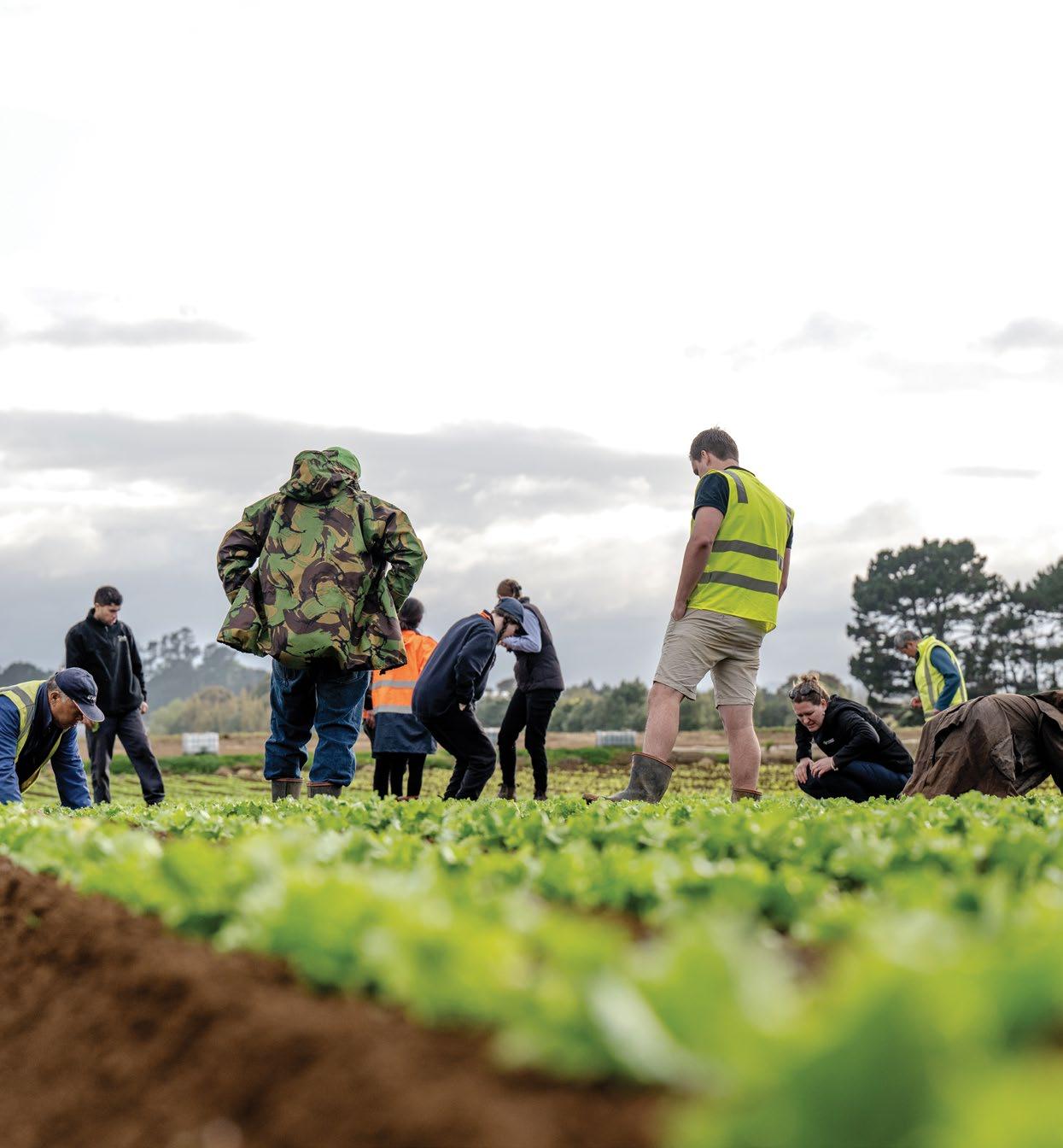
BALLE BROS HOSTED AN IPM DEMONSTRATION THAT PUSHED THE ENVELOPE
Photo courtesy of Plant & Food Research
HARVESTING CROPS WITH A LIGHTER TOUCH
Gina Jewell : A Lighter Touch programme

Harvesting marketable lettuce and broccoli crops using integrated pest management (IPM) is a significant step forward in supporting growers to take a lighter touch approach to food production.
That’s the view of Stuart Davis, Vegetables NZ’s representative and chair of the A Lighter Touch (ALT) Industry Stakeholder Advisory Group. ALT is co-funded by industry and the Ministry for Primary Industries.
“The ALT programme is about helping growers move from agrichemical reliance to an agroecological approach to crop protection, using a mix of softer chemistry, biocontrols and changes to farming practice.
“For growers to make that change to their crop management, we need to demonstrate it’s possible, and that’s exactly what we’ve delivered at the Pukekohe demonstration farm.”
The demonstration farm, hosted by Balle Brothers, is an ALT project with Vegetables NZ and Onions NZ. This growing season, the farm produced a marketable spring lettuce crop without any insecticide applications, followed by the successful harvest of a summer broccoli crop using 60 percent biological controls, and fewer spray applications than were applied to a comparable commercial crop.
“In addition to showing it can be done, we took growers and crop advisors with us on the IPM journey by sharing knowledge through hosting weekly IPM workshops,” Stuart says.
With support from Plant & Food Research and consultant Olivia Prouse, Vegetables NZ ran ten weekly workshops following the management of the spring lettuce crop, followed by a second series of weekly workshops focused on the summer broccoli crop.
Vegetables NZ research, development and extension manager Daniel Sutton said each workshop was comprised of both a field and classroom session.
“In the field, those attending scouted the crop with expert guidance, identifying pests, diseases, beneficial insects, and recording their findings for later discussion.”
The classroom sessions discussed the results from the field, management options, then decided next steps for the crop. Industry experts presented key information on pests and diseases such as aphids, caterpillars, Sclerotinia and downy mildew.
The classroom component could be attended online, so those not based in Pukekohe could also take part. Online participant Mike Arnold, LeaderBrand South Island general manager, attended remotely and highly rated the workshops.
TECHNICALTECHNICAL
NZ GROWER : MAY 2024 47
Participants with their certificates of attendance at the final spring lettuce IPM workshop, held at the Pukekohe demonstration farm. Photo courtesy of Plant & Food Research
IPM LETTUCE BLOCK – INSECTS
Aphid – Nymphs
Aphid – Winged
Caterpillar – larvae
Lacewing – egg
Lacewing – juvenile
Lacewing – adult
Parasitic wasp
This graph shows the beneficial and pest population trends in the spring lettuce crop. Aphid populations started to climb on two occasions, but in both cases beneficial insects gained control making spray treatments unnecessary. The second higher spike of aphid populations was just before the cover crop was mulched. Beneficial insects moved from the cover crop into the lettuce, resolving the pest problem in the crop
“It was great to have the different experts involved. With their knowledge, they were able to bring practical application to the workshops. As a result, my colleagues and I feel well-equipped and more confident to continue advancing integrated pest management in our growing practices.”
Mike’s experience was mirrored by many others, with participants reporting an average 50 percent increase in IPM knowledge growth from start to finish.
Daniel says the feedback via a post-event survey had been very positive, with nine out of ten respondents rating the workshops highly in terms of satisfaction. “Even more encouragingly, 93 percent said they would look to implement IPM practices in the crops they were either growing, advising or working on.”
Daniel says a key point of difference about these workshops was the continuous learning they enabled, unlike previous IPM workshops which were often one-off events, with little or no follow-up.
“With these workshops, we aimed to take participants through the growth of the crop, increasing their knowledge of pests, diseases and beneficial insects, and letting them see the impact of decisions on use of sprays, or not, on the crop and the insects present.”
Daniel is first to admit in terms of the crop management at the demonstration farm they pushed the envelope, but says that is the point of a demonstration site, to show what is possible.
“With the broccoli crop, we only used synthetics towards the end to protect the broccoli heads, and to control just one pest – diamondback moth (DBM).
“We had growers saying they really didn’t think we were going to get a harvestable crop with that approach, so it really was an awesome learning opportunity. Yes we took greater risks, but we still produced a commercial crop.”
The farm is also the site of a biodiversity project designed to increase beneficial insect populations in order to help manage pest insects. The impact of the beneficial insects was illustrated powerfully with the spray-free spring lettuce crop.
“With the lettuce crop, we were at the point of needing to spray for aphids when we mulched a nearby cover crop. Suddenly, all of these beneficial insects that had been living in the cover crop took up residence in our lettuce crop and overnight, our aphid problem disappeared,” Daniel says.
Balle Brothers crop manager Howe Young, who oversees the demonstration farm crops, freely admits he was totally surprised by the impact of the beneficials.
“I felt sure when the aphid numbers were reaching their peak we would need to spray, but we held off and next thing the aphid problem was gone. I never thought there were enough predators out there to do that.”
Howe is now keen to plant another cover crop which will flower around the same time next season, in order to ensure there is sufficient food and shelter to maintain the beneficial insect populations at the farm.
100 90 80 70 60 50 40 30 20 10 0 Incidence (%) 19/9/23 26/9/23 3/10/23 10/10/23 17/10/23 24/10/23 31/10/23 7/11/23 14/11/23 21/11/23
48 NZ GROWER : MAY 2024

Participants discuss the field findings and management options during a classroom session of the IPM workshops held at the Pukekohe demonstration farm. The classroom sessions also involved online participants. Photo courtesy of Plant & Food Research
Howe and Daniel both acknowledge that pest thresholds in the crops were significantly higher than growers would normally accept. But as Daniel says, it was the severity they were focused on, not the incidence of pests.
“We didn’t spray until three weeks out from harvest and once we started, we saw this nice decrease. By the time we did our last application, we had less than two diamondback moth caterpillars per plant at the key point of head formation.”
In using more biological products and fewer applications of synthetics, the IPM approach is also serving to prolong the life of the synthetic chemistry, with resistance being a very real issue growers are facing.
“DBM in particular is known to develop resistance pretty easily, so if we can demonstrate how to manage it differently, and not be reliant on repeated applications, that’s a real positive,” Daniel says.
From Howe’s point of view as a grower, the resistance management part of the story is central to why growers need to move away from agrichemical reliance towards an agroecological approach.
“I don’t think we’re going to save any money, but we’re going to be able to still produce marketable crops because we’re protecting our chemistry. It’s about keeping more tools in our toolbox for longer,” he says.
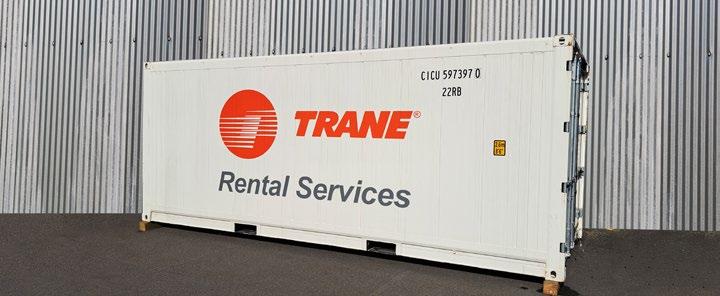


What you need, when you need, for how long you need, with full service support. The perfect solution for the season. Cool or heat it! Hire a Trane Refrigerated Container for Temporary Cooling or Heating Requirements Gary Morris Phone: 0272 836 949 Email: gary.morris@tranetechnologies.com For all temporary refrigerated containers or water chillers to suit your needs. Call us today. www.trane.co.nz NZ GROWER : MAY 2024 49

EL NIÑO IN A CHANGING CLIMATE
Anne Hardie
It may not have been the quintessential El Niño impact for New Zealand this year, but it showed how El Niños of the future may not match past experiences in a world of climatic variability and extremes.
As NIWA (National Institute of Water & Atmospheric Research) meteorologist Ben Noll says: “In the life of a meteorologist, there is hardly a dull moment these days”.
He says El Niño’s impact on summer dryness was delayed but not denied. Central New Zealand was most affected by dryness, with parts of the top of the South Island experiencing eight or nine months of below normal rainfall dating back to the start of winter 2023. Parts of Tasman and Marlborough experienced a severe rainfall drought, while parts of Wellington and Hutt Valley also experienced a rainfall drought.
Later in the season, dryness expanded to include more typical areas like Northland, Auckland, Coromandel Peninsula, Gisborne, and Hawke’s Bay, but because of its late start, it wasn’t as severe as areas farther south.
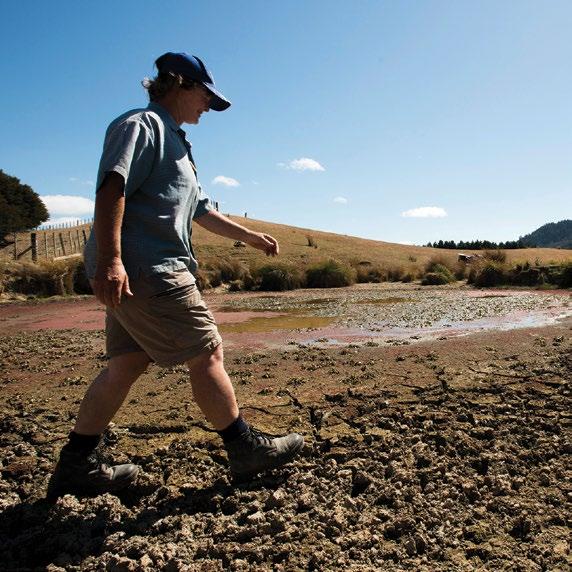
OUTLOOKS
of temperature, rainfall, soil moisture and river flows.
“IN
THE LIFE
OF A METEOROLOGIST, THERE IS HARDLY A DULL MOMENT THESE DAYS”
 BEN NOLL, NIWA METEOROLOGIST
BEN NOLL, NIWA METEOROLOGIST
Abnormally dry conditions persisted into early April for many areas, consistent with the expected longer tail of the El Niño event, and consequently the Ministry for Primary Industries classified a medium-scale adverse event for drought in many regions.
In a changing climate, he says El Niño and La Niña might affect weather patterns in different ways than in the past, and forecasters must be more prepared than ever for extremes that sit outside of historical bounds for a given location – be it rainfall or temperature.
Ben says it makes resources such as the artificial intelligence-based model, the drought tool, particularly important. Artificial intelligence-based models will need to be “retrained” at a regular interval, he says, so they can learn from more recent climate patterns rather than relying on the distant past.
“Emerging technology like artificial intelligence has the potential to be a massive boon to weather and climate forecasting. AI-based models can be run faster, cheaper, and more frequently than traditional physics-based models which require a supercomputer and take hours to run.
“Right now, we are assessing these models and finding that the AI approaches are providing predictions with skill that is on par with physics-based approaches. However, there are still advantages to the traditional physics modelling, which can provide predictions at a higher resolution.”
NIWA SEASONAL
niwa.co.nz/outlook
CLIMATE
Predictions
50 NZ GROWER : MAY 2024


NIWA’s New Zealand
Index showed the progressive dryness through the summer. Thanks to rainfall in mid-April hotspots in the upper

Soil was drier than normal throughout the summer for most growing areas. The mid-April rain resulted in moderate to large soil moisture increases across the western and central North Island, but additional decreases occurred along the east coast
Drought
South Island all but dissipated
NZ GROWER : MAY 2024 51
INTEGRATING SOIL N TESTING WITH THE SVS TOOL
Andrew Barber and Henry Stenning : Agrilink NZ
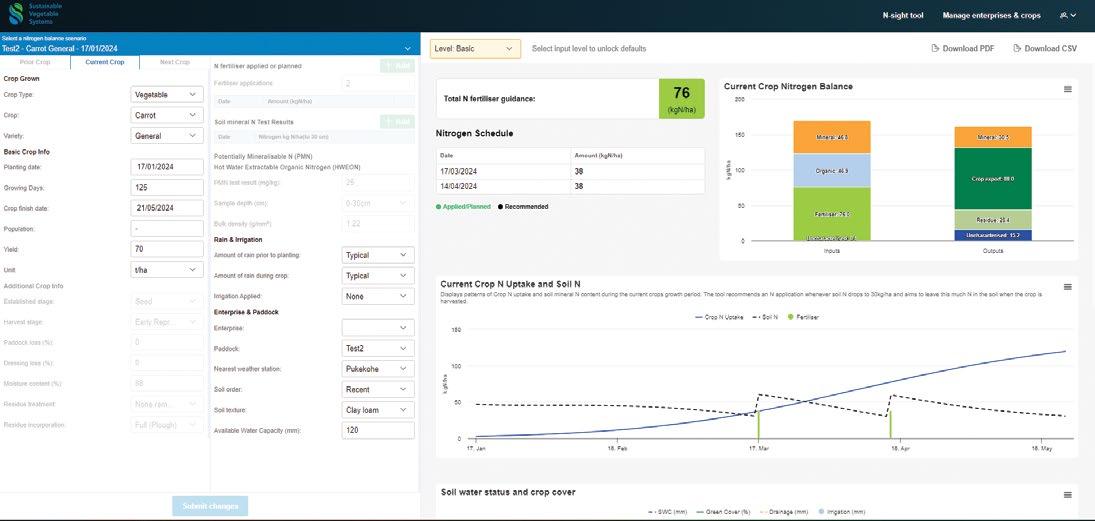
SUSTAINABLE VEGETABLE SYSTEMS –LATEST ACTIVITIES
All crops in the Workstream 2 regional trial sites have been harvested with data currently being analysed and used to ground truth the Sustainable Vegetable Systems (SVS) model outputs. Early results show good correlation between the SVS Tool and in-field monitoring.
Work continues on improving the model underlying the SVS Tool. This includes new and updated crop coefficients and the development and incorporation of crop residue mineralisation and nitrogen loss sub-models.
A series of upcoming workshops are to be held from March to May in the following regions: Nelson, Pukekohe, Hawke’s Bay, Christchurch, Invercargill, Ohakune, Manawatū, and Gisborne (see below for details). These workshops will demonstrate the SVS Tool and discuss how it integrates with soil nitrogen testing and within the nutrient management decision making process.
Workstream 1 data analysis
The SVS Tool provides nitrogen application guidance based primarily on predicted crop nitrogen uptake, balanced by an assortment of other inputs and outputs. The key coefficients determining predicted nitrogen uptake by crop are yield, harvest stage, and nitrogen content. Plant & Food Research has been analysing the data collected from the intensive field trials conducted in Hawke’s Bay and Canterbury to determine the values for these coefficients for each crop.
Cultivar-specific coefficients have also been developed for some crops (e.g., potatoes) with greater levels of variety specific variation.
Other coefficients analysed included dry matter percentage and harvest index (the partitioning of nitrogen between the marketable crop and residue), with the results of these analyses being used as default values within the SVS model.
TECHNICAL
beta version of the SVS Tool can be accessed now at www.svstool.co.nz
A
52 NZ GROWER : MAY 2024
Model development
Significant progress has been made with model development over the past several months, with the incorporation of new coefficients and sub-models, as well as testing and calibration using data from Workstreams 1 and 2.
Soil nitrogen predictions and utilisation of soil tests have been improved through connecting the tool to 46 climate stations around New Zealand. This has substantially increased the accuracy of nitrogen mineralisation predictions as well as the outputs from the drainage sub-model.
A sub-model that has been developed, and is currently being incorporated into the tool, is for crop residue mineralisation. This model predicts nitrogen mineralisation from the Carbon: Nitrogen ratio of crop residues, influenced by soil temperature and moisture – similar to the soil organic matter mineralisation. High Carbon: Nitrogen ratio crops generally show less mineralisation than crops with lower ratios. Indeed, high Carbon: Nitrogen arable crops such as wheat and maize often show an immobilisation effect, where mineral nitrogen in the soil decreases following residue incorporation. In contrast, vegetable crops such as brassicas can release a significant quantity of mineralised nitrogen following residue incorporation.
Model testing
To ensure that the guidance provided by the SVS Tool corresponds well with observed measurements taken from real growing operations, a validation system has been set up to test model outputs against observed readings from Workstream 2 monitoring around the country.
Early indications from this testing are that the model outputs correlate well with in-field observations, though if significant discrepancies are to occur as testing continues these will be investigated, and any necessary adjustments made to the model. Other datasets that will be used to calibrate the model are the Workstream 1 field trial data, additional crop coefficient data for pea and potato varieties, and data from the SFF (Sustainable Farming Fund) project ‘Mineralisable N to improve on-farm management.’
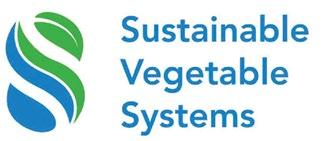
This testing is currently at an early stage, however in a future update article we anticipate being able to report on the results of this validation, and any changes made to the model in response to the testing programme.
Upcoming developments
In anticipation of programme completion in June, a series of workshops are underway around the country, demonstrating the SVS Tool and promoting its place on farms as a decision support tool:
PUKEKOHE
10 April at the PIA Events Centre
HAWKE’S BAY
11 April at the Havelock North Function Centre
CHRISTCHURCH
16 April at the Hotel Ashburton
INVERCARGILL
17 April at the Ascot Park Hotel
OHAKUNE
30 April at the Powderkeg
MANAWATŪ
1 May at the Distinction Coachman Hotel
GISBORNE
9 May at the Bushmere Arms
Continued user-testing, as well as feedback from the upcoming workshops, will lead to further improvements to the user-interface within the SVS Tool. The crop and scenario management window is being redesigned, which will improve the experience for users with large numbers of paddocks and crops and simplify scenario creation, selection, and update processes for all users.
For any questions or comments on the Sustainable Vegetable Systems programme, please email the programme manager Andrew Barber andrew@agrilink.co.nz







NZ GROWER : MAY 2024 53
PRODUCT GROUPS
ALL THE LATEST NEWS FROM YOUR PRODUCT GROUPS

IS IT TIME TO LOOK AGAIN AT POTATO EXPORTING OPPORTUNITIES?

POTATO EXPORT OPPORTUNITIES
Kate Trufitt : Potatoes NZ chief executive
Potatoes NZ is continually investigating and assisting in the development of current markets and new market opportunities for fresh New Zealand table, processing and seed potatoes. We also assist with market access opportunities and issues should they arise.
Export opportunities
While the volumes remain constant the value has increased each year to 2023. Other island nations take only small amounts of potatoes and are more difficult to export to due to shipping.
With Australia growing their fresh export to Asia, is it time to look again at other countries for potato exporting opportunities? South Korea is the top Australian fresh potato export destination, from 2022 to 2023 there was an increase in export value by 21 percent to AUD $15 million and an increase in export volume by five percent, with growth to 20,531 tonnes.
More collaborative work with government needs to be done in this area as well as the development of
international relationships, for New Zealand to realise its exporting potential.
Fall armyworm and exports
Recently fall armyworm (FAW) affected exports into Fiji due to Fiji notifying that fall armyworm is a pest of concern, highlighting the risk Potatoes NZ incurs having Fiji as its largest market. The Ministry for Primary Industries acted quickly and promoted New Zealand’s phytosanitary system as being robust enough to prevent the spread of fall armyworm to Fiji.
Fall armyworm reached New Zealand is 2022, likely from Australia. The moth is known to be spreading around the world and is present in the Americas, Africa and Asia, as well as part of Australia. In April 2023, Biosecurity New Zealand and sector partners agreed to shift the FAW response to long-term management.
Potatoes is not a known host for fall armyworm, however it can occur in the potato plant leaves. Because it is prevalent in maize as well as sweetcorn, and attacks over 350 plant species, it can survive on potatoes, capsicums and aubergines. Potatoes NZ will work with growers on survey and education measures over the next 12 months.
Propham® Potato Dust | Prevents sprouts on fresh potatoes

It is a key part of good storage or shipping practice to apply Propham® Potato Dust to prevent sprouting and to keep potatoes fresh, preserve natural flavour, flesh quality and texture.
Easily applied during loading of potatoes
Just one treatment is normally sufficient to keep tubers in condition for 8 months at 6–8oC
Propham® Potato Dust is packaged in 25kg bags for commercial use
Propham® Potato Dust is an ACVM MPI Registered product P003465
Contract Packaging & Storage (2021) Ltd | Phone: +64 (0)7 575 8853

Email: orders@contractpackaging.co.nz | Web: www.contractpackaging.co.nz/prophampotatodust




Manufactured and supplied by
NZ GROWER : MAY 2024 55
EXPORT OPPORTUNITIES
WHAT’S HAPPENING?
Potatoes NZ has an exciting year ahead with several positive initiatives planned, including:


MOTHER’S DAY PROMOTION
Sunday 12 May
In May, Potatoes NZ will acknowledge and celebrate the wonderful mothers in our lives by running a Mother’s Day Promotion in collaboration with Griffin’s New Zealand. Check out the website for more details: potatoesnz.co.nz/news-info/ promotions/mothers-day
For more information about these activities and what Potatoes NZ is currently working on, please visit www.potatoesnz.co.nz


INTERNATIONAL DAY OF POTATO – HARVESTING DIVERSITY, FEEDING HOPE
Thursday 30 May
The potato is one of humanity’s most important and universally loved staple foods. In 2024, we celebrate the first United Nations International Day of Potato by focusing on the contribution of the potato to the lives of producers and consumers. Potatoes NZ has various promotions running to mark this day as a significant one in New Zealand and around the world.

WORLD POTATO CONGRESS –ADELAIDE, AUSTRALIA
23–26 June 2024
The 12th World Potato Congress in Adelaide from 23 to 26 June, marking a pivotal moment for the global potato industry. Beyond the opportunity to showcase the excellence of the potato sector on the world stage, this congress aims to catapult potatoes into the spotlight as a compelling, nutritional and health-conscious food choice, both domestically and internationally.
2021 2022 2023 Destination Volume (tonnes) FOB Value ($) Volume (tonnes) FOB Value ($) Volume (tonnes) FOB Value ($) Fiji 20,551 16,296,237 18,721 21,041,723 18,531 27,979,753 Cook Islands 278 221,621 308 364,199 315 489,011 French Polynesia 1,352 1,090,669 1,174 1,331,782 1,305 2,006,505 Malaysia 5 4,318 366 332,251 352 486,393 New Caledonia 136 102,384 774 762,084 1,397 1,927,856 Samoa 1,285 876,833 706 708,948 1,336 1,785,011 Other 1,019 997,002 653 966,842 707 1,389,434 Total 24,626 $19,589,064 22,701 $25,519,799 23,941 $36,063,963
56 NZ GROWER : MAY 2024


UPDATE FOR TOMATO GROWERS
Dinah Cohen : TomatoesNZ business manager
Commodity Levy Renewal – voting starting
Voting for the Commodity Levy renewal starts on 15 May – please make sure that you vote.
If we have your mobile phone number, you will receive a text message with a link to the voting forms to make it easier for you to place your vote.
Without your vote, TomatoesNZ might not have the numbers required to continue with the Commodity Levy funding system that we currently have in place and TomatoesNZ won’t be able to continue to do the work that happens every day for you, the grower.
When you vote, you will need to complete ALL the questions asked – if you support the proposal AND your production totals.
If you fail to answer both questions, your vote will automatically go down as being a ‘no vote’ that you don’t support the proposal.


For more information about the Commodity Levy: www.tomatoesnz.co.nz/commodity-levy
CONTACTING TOMATOESNZ
Energy workshops
As the temperatures decrease around the country, TomatoesNZ is supporting Vegetables NZ in running two energy workshops open to all covered crop growers entitled ‘Reducing your energy bill’. These will be held in:
AUCKLAND
23 May, 12pm – 5pm
30 Walters Road, Takanini
CHRISTCHURCH
27 May, 12pm – 5pm 1 Harewood Road, Papanui
The workshop will cover:
• A look at energy saving devices in use at Zealandia Horticulture.
• Tools to help all covered crop growers understand what might be available for their unique greenhouse to both reduce the energy demand and consider fuel types other than waste oil, gas or coal.
RSVP to ellery.peters@freshvegetables.co.nz
My email address has permanently changed to dinah.cohen@tomatoesnz.co.nz so please use this email address when trying to contact me to ensure that I receive it.
NZ GROWER : MAY 2024 57
New Seed testing pricing at PHEL
Due to new measures that are in place regarding how seed is now tested at the Plant Health and Environment Laboratory (PHEL), there has been a reduction in pricing as follows.
The blue pricing came into effect on 2 April, while the orange pricing comes into effect on 1 July 2024. PHEL wanted to offer the new multi tests and cost savings before they move to the new prices in July. It is imperative that all seed coming into New Zealand is free of viruses.
**Sequencing required to ID species if positive $100 excl. GST *Discounted pricing provided for testing >10 samples
Marc Groenewegen
TomatoesNZ was thrilled that Marc – a passionate and extremely knowledgeable covered crop grower from the Netherlands – was able to share some of his expertise with our industry at a Q&A session at the end of March. Marc covered topics such as agrichemicals, growers using less energy as a result of increasing fuel prices, achieving balance, vigour and good fruit quality when moving from winter to spring-like conditions, and his experiences with and knowledge of ToBRFV (tomato brown rugose fruit virus).
For the last topic, Marc’s advice was two-fold – keep it out of the country, and improve greenhouse hygiene levels so that they become standard in every growing site so that you can hope to keep it out of your business. This has, in part, sparked our inclusion of good hygiene practices as a topic at our AGM presentations.
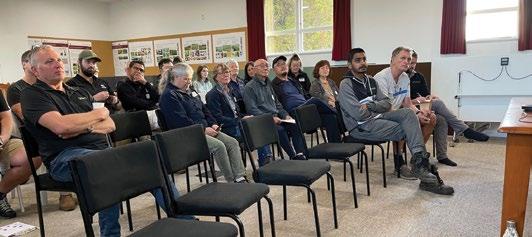

CURRENT PRICING NEW PRICING Current testing New Testing (74.6% cost reduction) New Testing (75% cost reduction) Item $Cost/ sample (1st sample) $Cost/ sample (additional samples) $Total Item $Cost/ sample (1st sample) $Cost/ sample (additional samples) $Total Item $Cost/ sample (1st sample) $Cost/ sample (additional samples) $Total NA extraction (12 bulk extractions/ lot) 105 50 655 NA extraction (3 bulk extractions/ lot) 105 50 205 NA extraction (3 extractions/ lot) 50 50* 150 RT–qPCR Tobamo generic (for ToMMV)** 90 25 365 Multiplex RT-qPCR ToMMV, ToBRFV 92 27 146 Multiplex RT-qPCR ToMMV, ToBRFV 65 65 195 RT-qBRFV ToBFR 90 25 365 Total $1,385.00 Total $351.00 Total $345.00 $1,592.75 (incl. GST) $403.65 (incl. GST) $396.75 (incl. GST)
Dutch tomato specialist Marc Groenewegen shared his expertise during a Pukekohe workshop
58 NZ GROWER : MAY 2024
TomatoesNZ Workshop & AGM
TomatoesNZ would like to extend an invitation to all growers to attend a mini conference of presentations that will form part of our Annual General Meeting (AGM). Topics to be covered:
• Hygiene measures to mitigate the threat of viruses
• How seed companies are safeguarding our industry
• Learnings for greenhouse integrated pest management from our trial with A Lighter Touch using biological controls.
DATE 8 August
VENUE Navigation Homes Stadium, Franklin Road, Pukekohe
TIME 12pm – 5pm
RSVP forms.office.com/r/GR3nEd2buz or use the QR code

A travel subsidy is available for those attending in person from outside of the Auckland region. Contact me for more details on how to apply dinah.cohen@tomatoesnz.co.nz
Fall Armyworm (FAW)
Over the summer months populations of fall armyworm (FAW) were found up and down the country feeding on their preferred food of corn and maize. Now that these crops have been harvested, FAW is still present in New Zealand and will seek out alternative food sources. This COULD mean that a FAW moth might fly into a greenhouse and feed on your crops.
Please be vigilant when scouting – know what the caterpillar looks like and inspect yellow sticky traps for the moths. If you aren’t sure, please photograph what you see (using the guide below) and email to me: dinah.cohen@tomatoesnz.co.nz. I can help you get an identification and advice on how to get rid of the pest should you find it.
Here is a guide on what to photograph: thebeatsheet.com.au/ wp-content/uploads/2020/04/ CaterpillarIdentification-Taking Photos-24March20.pdf



Upper North Island Alan McKee, Mobile: 021 956 701, Email: alan.mckee@tnseeds.com East Coast & Manawatu Graeme Jackson, Mobile: 021 396 359, Email: graeme.jackson@tnseeds.com Ohakune & Horowhenua Kathryn Wells, Mobile: 021 475 482, Email: kathryn.wells@tnseeds.com South Island David Stewart, Mobile: 021 352 764, Email: david.stewart@tnseeds.com Auckland/Protected Cropping Ingrid Ennis, Mobile: 021 435 493, Email: ingrid.ennis@tnseeds.com Freephone: 0800 TERRANOVA (0800 837 726) Customer service: Ph: 09 275 1919 www.terranovaseeds.co.nz LK-TS168 Thinking vegetable seeds? Think Terranova. ELK Onion KiwiGold High quality export onion. Long storage onion with excellent shipping potential. Uniform globe shape bulbs with good size uniformity, firm with very good skin quality. Excellent pack-outs. Reliable performer over many years. NZ GROWER : MAY 2024 59


PLEASE REMEMBER TO VOTE: WE’D LIKE YOUR CONTINUED SUPPORT
Antony Heywood : Vegetables NZ general manager

By the time you read this column in early May, the vegetable research and levy roadshows will just about all be over and the voting papers for the various commodity levies will just about be in your inbox or mailbox.
Over the past few weeks I have enjoyed attending the roadshows and meeting with as many of you as possible. It’s very important that we know what you need and you know what we are doing in response, and how you can engage with us.
We plan to run another roadshow series around research next year, because this year’s series has been so popular. We will also continue to run workshops at the demonstration farm in Pukekohe. It’s been great that growers from outside of Pukekohe have been able to join the two sets of workshops on integrated pest management online. While obviously not as good as being there in person, feedback is that joining online worked well.
In summary, the money we collect from you via the fresh vegetables Commodity Levy is used to fund:
• research, development and extension
• advocacy in key areas such as land and water use, agrichemical and biological inputs, and labour
• promotion of the consumption of vegetables.
Getting things done has been the mantra of the Vegetables NZ board and management over the past three years. We have stepped up activity in all these areas and what we would like to do is step up this activity still further, through your continued support of our Commodity Levy.
Please make your views known by voting before 14 June. In the interim, if you have any questions, please contact me directly on 021 998 038
Food security
The theme of this issue of NZGrower is food security. Being able to provide New Zealand with food security in terms of locally grown, fresh, healthy vegetables is the main driver behind Vegetables NZ’s objective to ensure growers have a pathway for consent as a permitted activity.
The new coalition government supports this aim. We are working with Ministers, government officials and Horticulture New Zealand on achieving this aim in the best way possible for growers. Part of this work is ensuring that industry assurance schemes such as Good Agricultural Practice (GAP) are recognised so as to reduce duplication in the area of grower compliance.
Access to skilled, motivated people
In order to provide food security, the vegetable industry – just like other parts of the horticulture sector – needs access to skilled, motivated people in high numbers, particularly during seasonal peaks. In mid-May, leaders from throughout the vegetable industry and horticulture sector will come together to quantify skill and labour needs for vegetable production. This is a first of its kind workshop focused on vegetable production and working out what a long-term solution could look like. We will then share that solution with Ministers and government officials, and continue our work with HortNZ to ensure the entire horticulture sector can achieve its objectives, as outlined in the Aotearoa Horticulture Action Plan
60 NZ GROWER : MAY 2024


THE ONION HARVEST AND EXPORT MARKETS

The onion harvest by and large has gone well for growers across the country, with the limiting issue being export sales. Overall, the quality of the onions being harvested is much better than in recent years and most are happy with the yield. The headache is now how do we get enough product out the door to have the bins and storage space for the onions coming off the ground still.
With the exceptional quality this year, we are likely to see a much longer export season, particularly to Southeast Asia.
European Union
Europe is shaping up to require a normal amount of onions, rather than the optimistic amount first signalled last November – December. With the European Union Free Trade Agreement now coming into force earlier than expected however, it will reduce the tariffs on New Zealand onions from 1 May, which is a significant talking point and of benefit to New Zealand over our competitors in Australia.
Indonesia continues to be our leading market, both in terms of pricing and headaches. We continue to work through the latest requirements. However, in the market the Dutch product is flushed through the system and there is good demand for New Zealand onions. It will be extremely difficult for Dutch exporters to supply the Indonesian market with the Red Sea tensions and latest export requirements.
Japan, Taiwan, Malaysia, Thailand
There appears to be relatively normal demand for this time of the year in these markets.
Commodity Levy Referendum
We are going out to members currently to renew the Commodity Levy for onions. We are proposing no substantial changes to the onions Levy Order and only minor wording changes to the activities covered. If you have not received any information from Onions NZ and you grow bulb onions, please contact James Kuperus to ensure we have your details correct. The voting commences in mid-May and runs for a month. If you have any questions about what is proposed or want to clarify anything, contact: james.kuperus@onionsnz.com
Indonesia
James Kuperus : Onions NZ Inc. chief executive
Onions being harvested this season in Hawke’s Bay. Photo by Bonnie Flaws
NZ GROWER : MAY 2024 61
in winter / spring

Winter / Spring harvest from Mid July to end of October in Pukekohe. Good head size frame balance. Sure heading. High pack out. Contact us now to arrange seed for sowing now.
www.enzazaden.com
email: sales@enzazaden.co.nz
• Phone +64 9 963 0122
Icemaker iceberg lettuce,
now, harvest
sow





















































 The kūmara harvest has bounced back and Kaipara Kūmara has resumed supply to Proper Crisps
The kūmara harvest has bounced back and Kaipara Kūmara has resumed supply to Proper Crisps
















 A grower in the Solomon Islands, part of a women-led growing co-operative that supplies cacao to New Zealand-based The Cacao Ambassador. Photo courtesy PTI NZ
A grower in the Solomon Islands, part of a women-led growing co-operative that supplies cacao to New Zealand-based The Cacao Ambassador. Photo courtesy PTI NZ












































 BEN NOLL, NIWA METEOROLOGIST
BEN NOLL, NIWA METEOROLOGIST





































